1lumen selects and reviews products personally. We may earn affiliate commissions through our links, which help support our testing.
Lumintop Mach 4695 V2 review
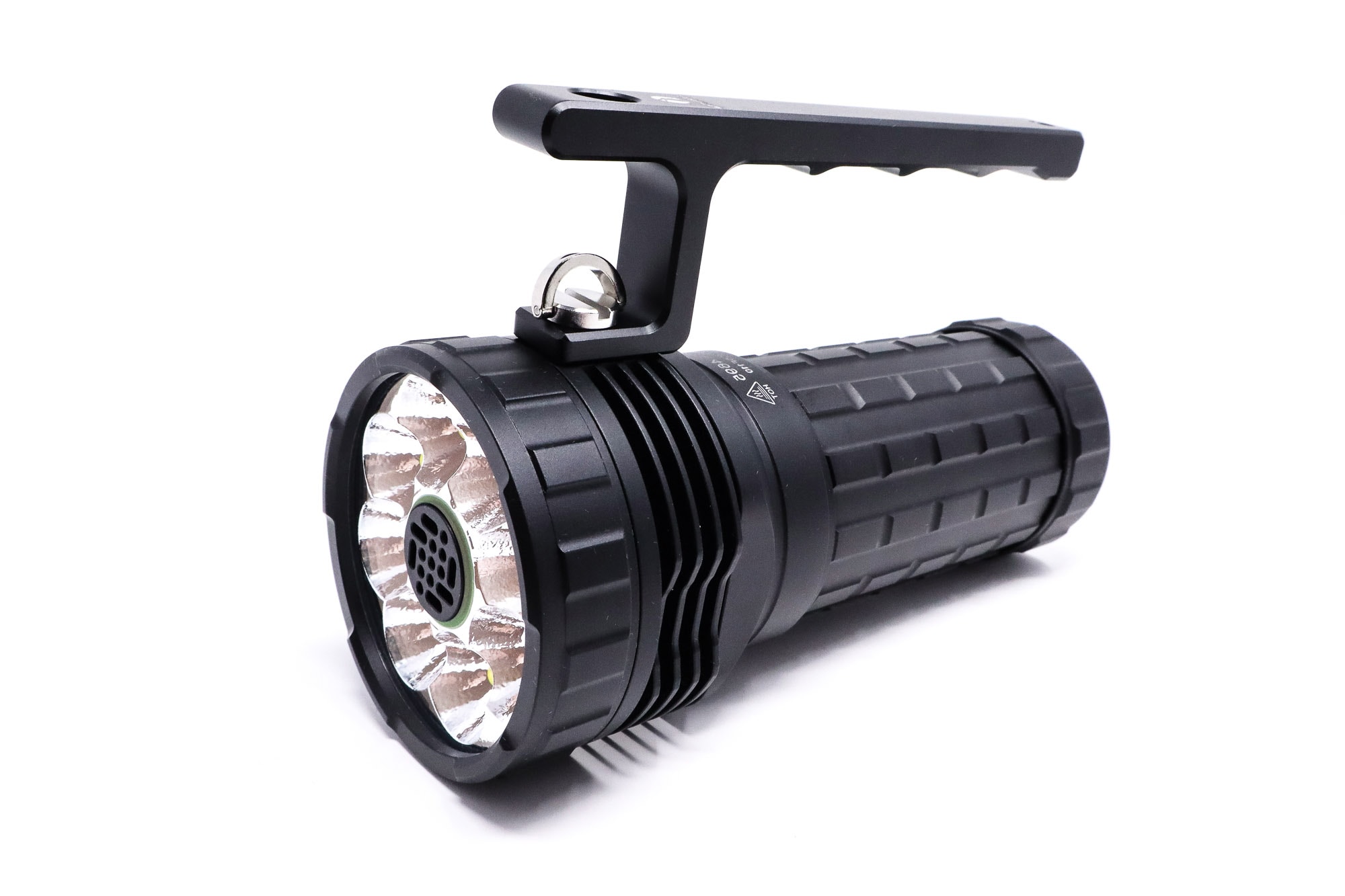
Lumintop Mach 4695 specifications
| Brand & Model | Lumintop Mach 4695 V2 |
|---|---|
| Flashlight category | High output |
| LED | 8*Cree XHP50.2 HD |
| Max. output | 26,000 lumens |
| Max. beam distance | 520 meters |
| Max. beam intensity | 67,500 cd |
| Battery config. | 46950 |
| Onboard charging | USB type C |
| Main modes | 4 |
| Blinkies | Strobe, SOS, Beacon |
| Waterproof | IP68 |
| Review publication date | March 2024 |
Review intro:
The Lumintop Mach represented a fundamental shift in the flashlight hobby that was long overdue. Before the Mach came out, if you wanted an actively-cooled flashlight (e.g. one with a fan), you had to throw down some serious cash. The Acebeam X70 was about $600 when released, or the Imalent offerings which ran about $400-$600. This was late 2018 mind you, and we all know flashlight tech has advanced since then. Fast-forward to 2022, you could get the Wuben X1 for about $180 US, but for the big output lights (over 20,000 Lumens), you were still shelling out $300 and up for a fan cooled light.
The Mach changed the game…a lot.
For $200 (direct from Lumintop), you could get yourself a 20,000+ Lumen flooder that had serious sustained output and joining the ‘fan club’ no longer meant selling your kidney. I reviewed that one and it more or less met my expectations with a caveat: Short runtimes for higher outputs. In late 2023, another player entered the arena that changed the game: The 46950 li-ion cell was brand new to the flashlight world and flashlight manufacturers were slow to adopt it. Amutorch did offer it in the DM90S, which I also reviewed, and it helped the runtimes a lot, but that light couldn’t make full use of the output potential. Well, no more. Up for review today is the Mach 4695 V2. It’s basically the same Mach as before, but ditches the 3x21700s along with logistical alterations to accommodate the big cell, but the essence of the Mach is the same. Fan-cooling on the cheap with more runtime. Sounds good!
Note: Some of the review content is taken from the Mach V1!
What’s in the package
The Mach 4695 V2 is packaged identically to the original in a magnetic closure elegant black on black box. It’s very nice. Inside the Mach sits in cut foam with some accessories and goodies. Here’s what’s inside:
- Mach 4695 V2
- Lumintop branded 32,000 mAh 46950 battery
- Carry handle
- Instruction guide
- Carry bag
- O-rings
- Screw in sling/lanyard mount
This is a ready to run kit. The battery was installed in the light and had an isolator between the driver and battery. The cell was sitting at 3.7 volts, so it needed to be fully charged. It’s usable out of the box, but full output is not available. I really liked the carry bag, a velveteen type velour with a drawstring.
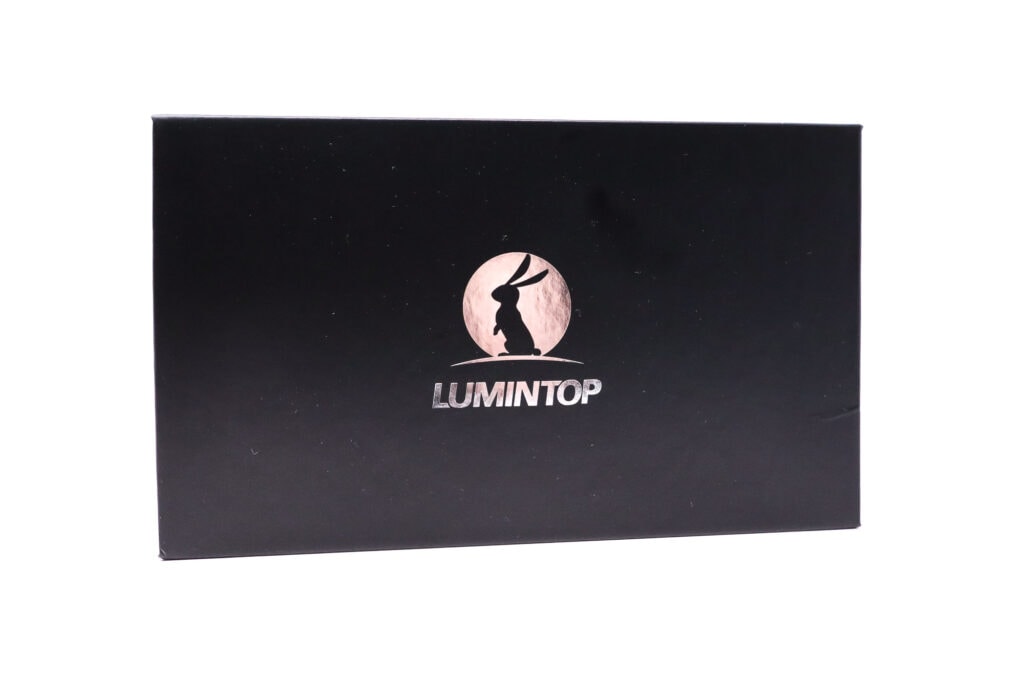
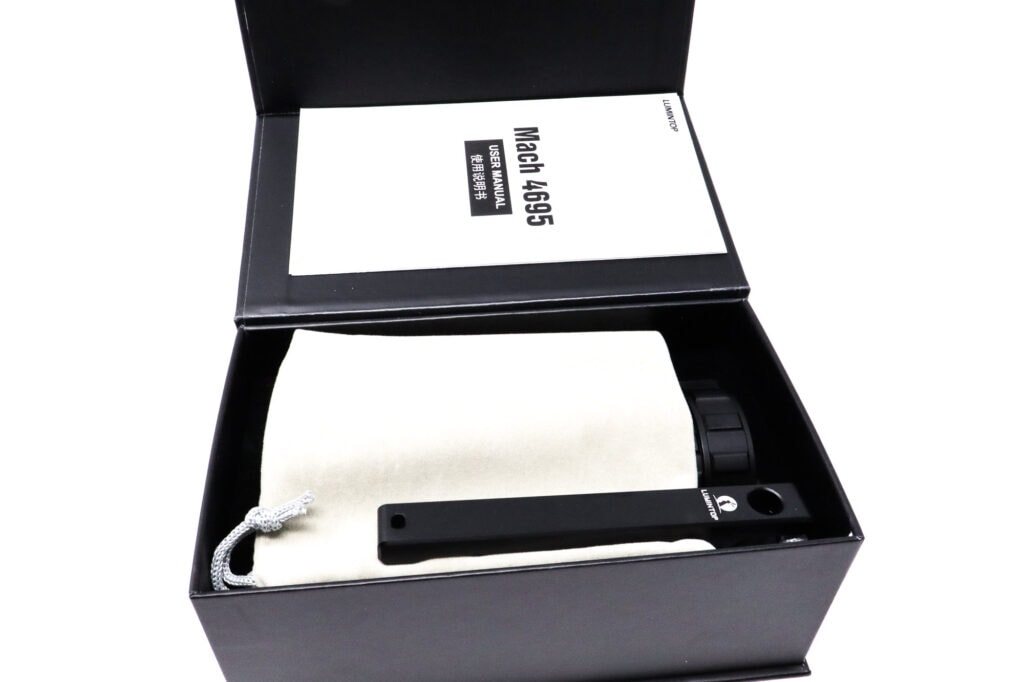
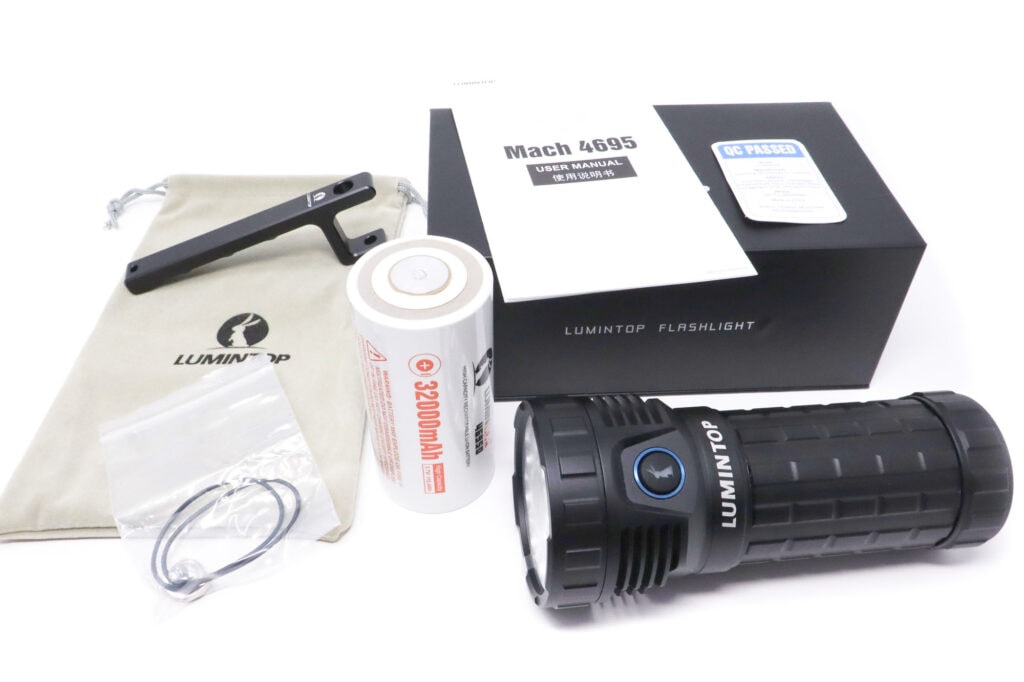
Flashlight in use, Build Quality, and Warranty
The Lumintop Mach is a high output general purpose flashlight. It can make a lot of light and spread it out over a large area with pretty good distance. These types of lights are usually sporting multiple batteries, bulky, and heavy, so you’ll be toting this around on the lanyard or by the included carry handle, which Lumintop includes with the V2. The handle is simple with no switch, just a handle. It’s affixed to the backside of the light opposite the switch, so you need both hands to use it with the handle.
Lumintop does include a screw-in stud with a swiveling bail that threads into a ¼ x 20 threaded socket. This would also be an attachment point for a tripod shoe. It fit fine on my tripod, and any shoulder strap would work. I do think a holster would be the best method for carry, but you need one that can accommodate a longer flashlight. There’s no other mounting points on the light. The Mach’s form factor is instantly recognizable as the soda or soup can style. These are short, chubby lights with large-diameter bodies. The battery tube is identical to the Mach V1 (just longer). It’s wide, and while my big meat mitts didn’t have trouble handling it, I’d imagine folks with smaller hands might. Lumintop did an okay job designing the battery tube since it has a lot of squares with abrupt edges that really aids in gripping. The host is similar to GT3 Pro, and identical to the Thanos 23.
The tailcap has nice polygonal gripping surfaces, and so does the bezel. I’d say every bit as good as traditional knurling. For a big light, it’s pretty maneuverable. Switching duties are handled by a single e-switch aft of the head. The rubber button has a translucent part shaped like the Lumintop bunny with LEDs behind it for on state charge status, LVP, and shows whether the fan is turned on or off. It’s set in a snazzy blue anodized aluminum bezel.

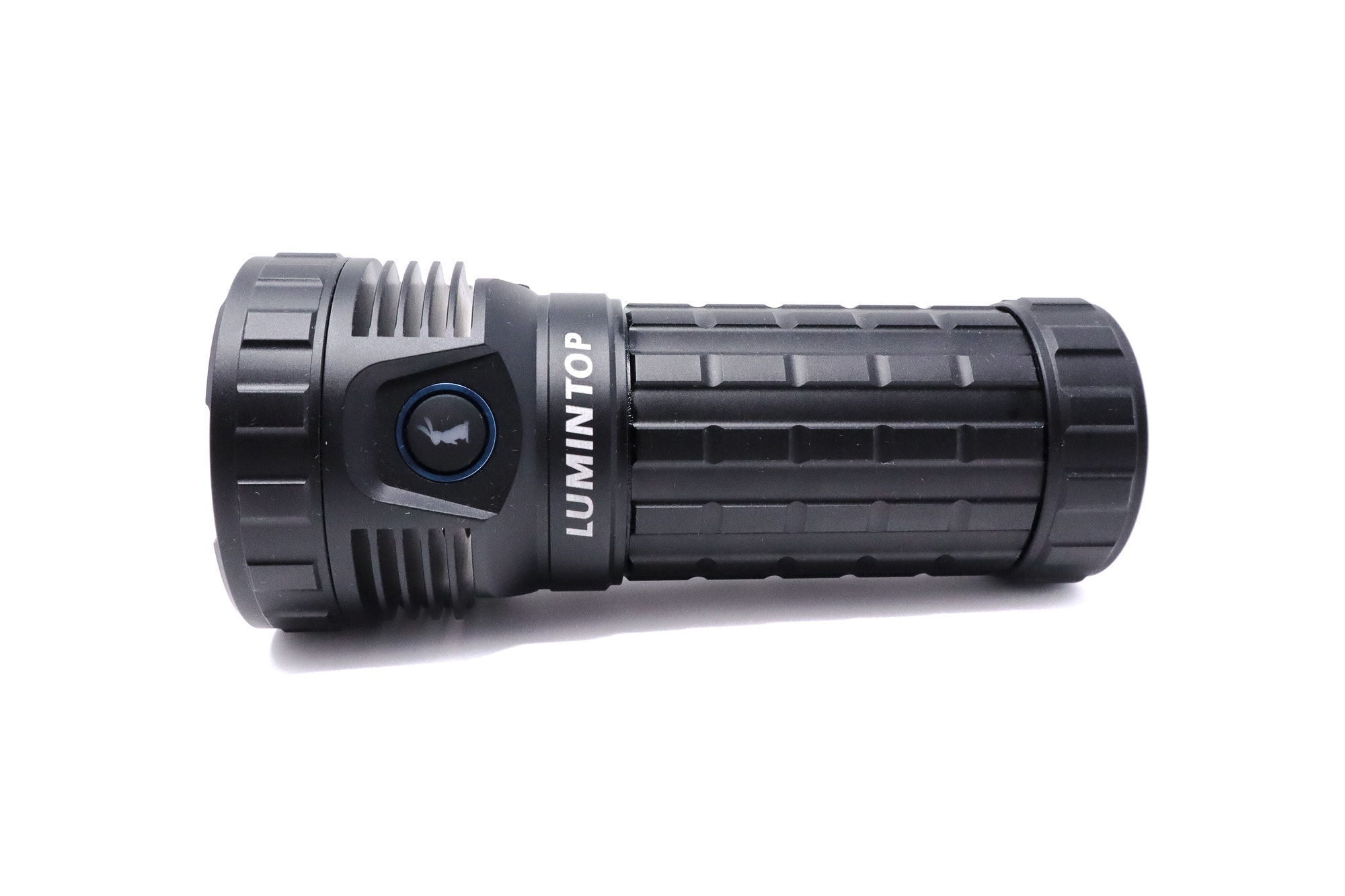
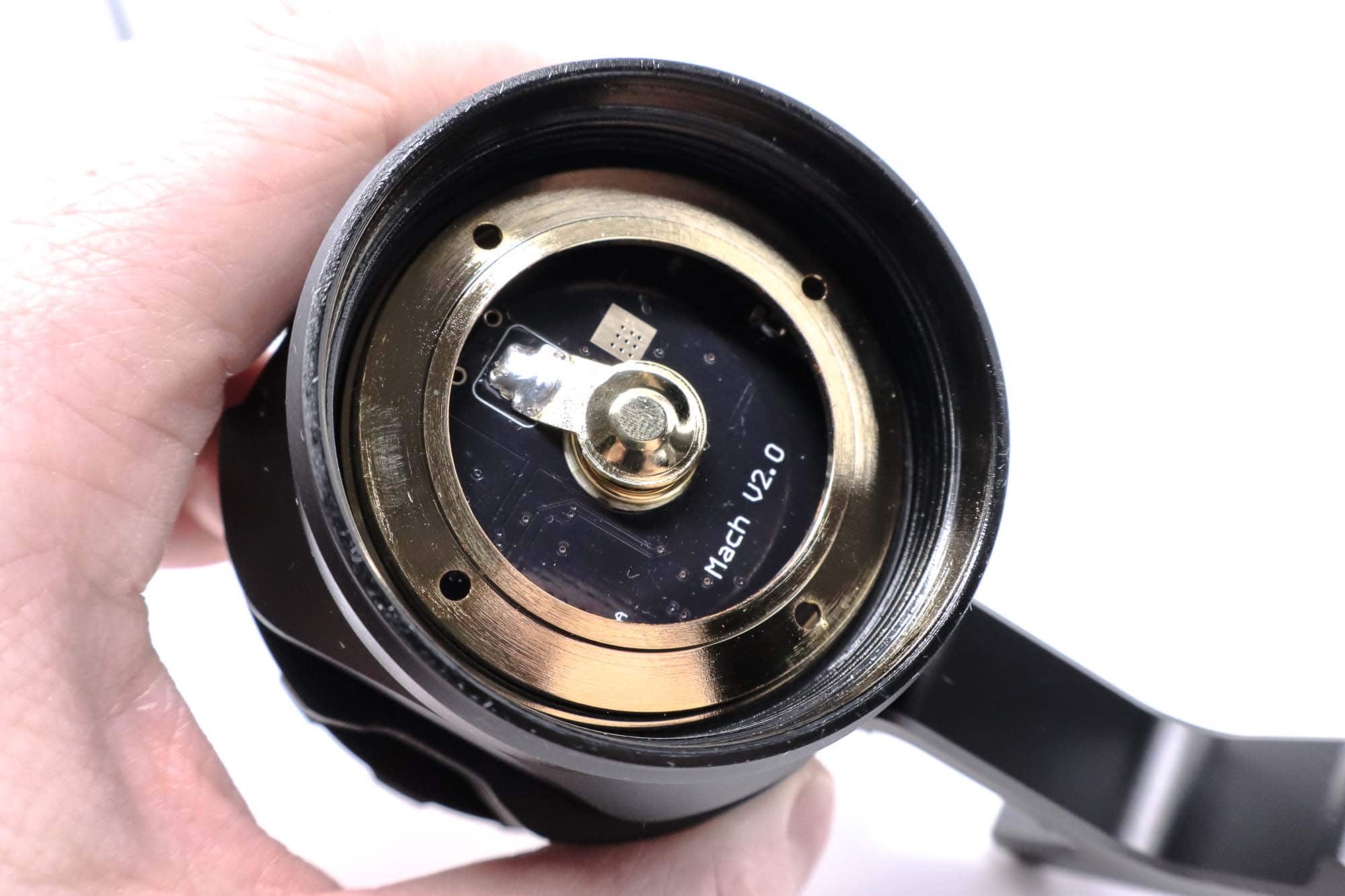
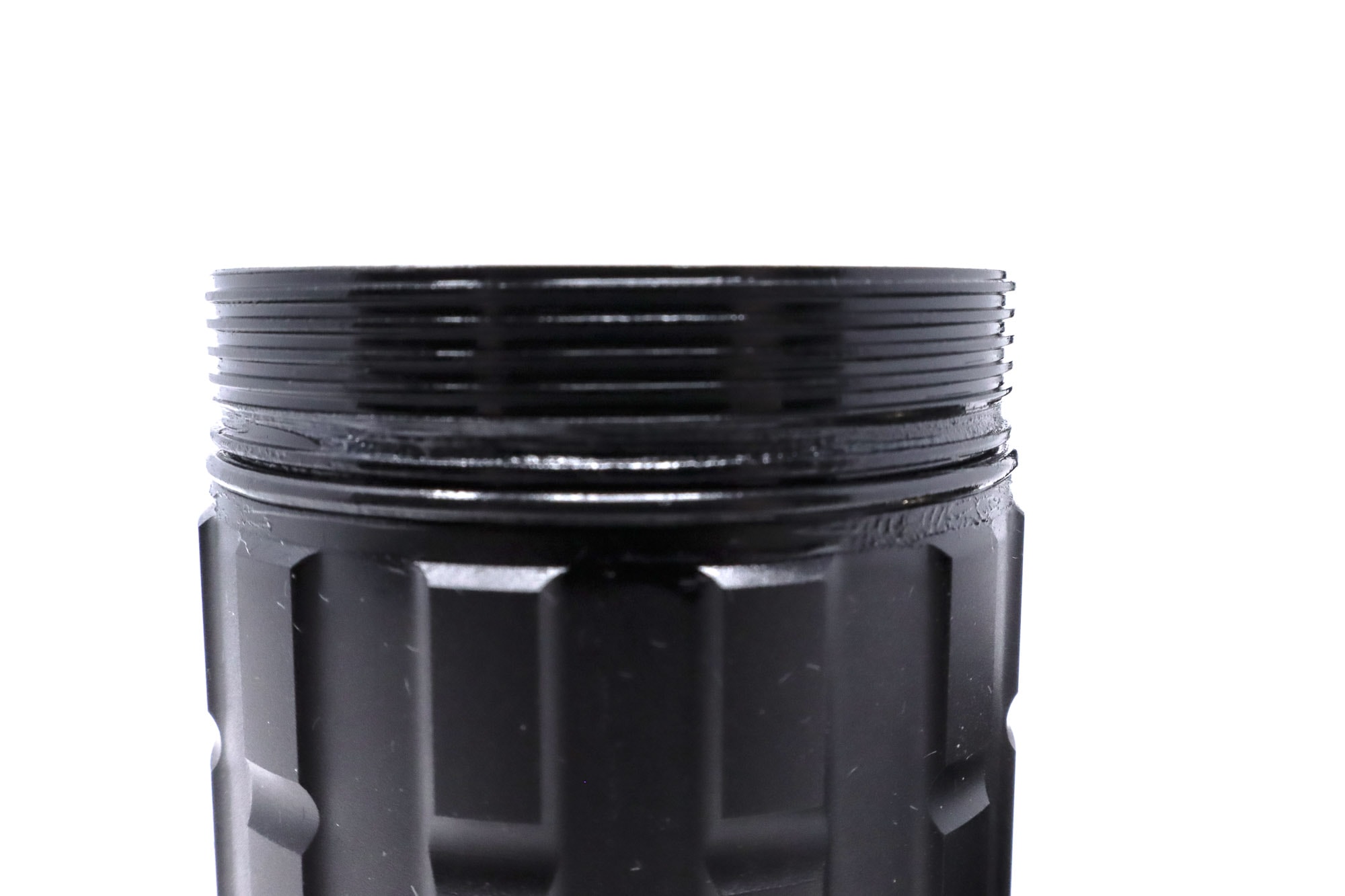
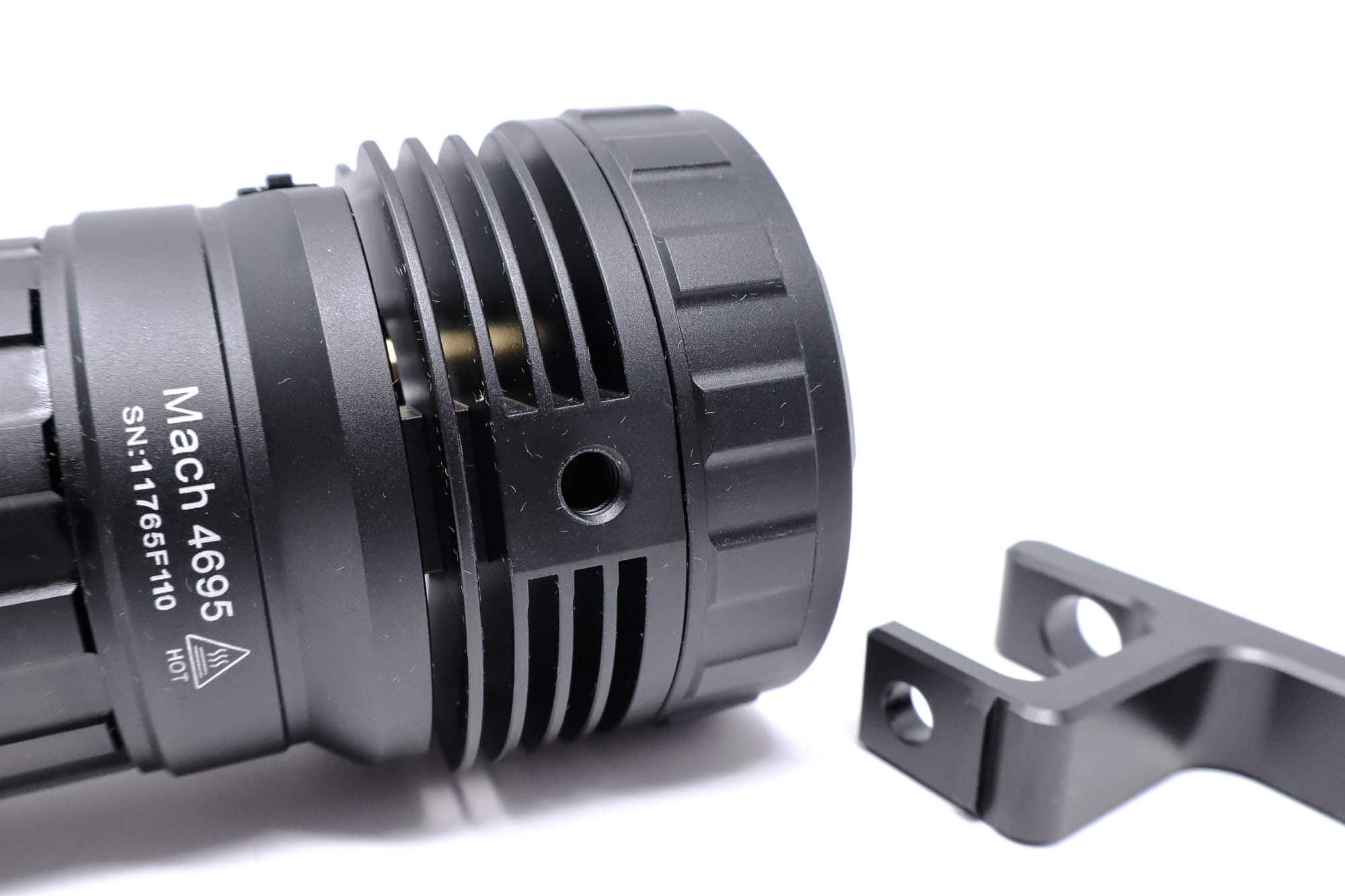
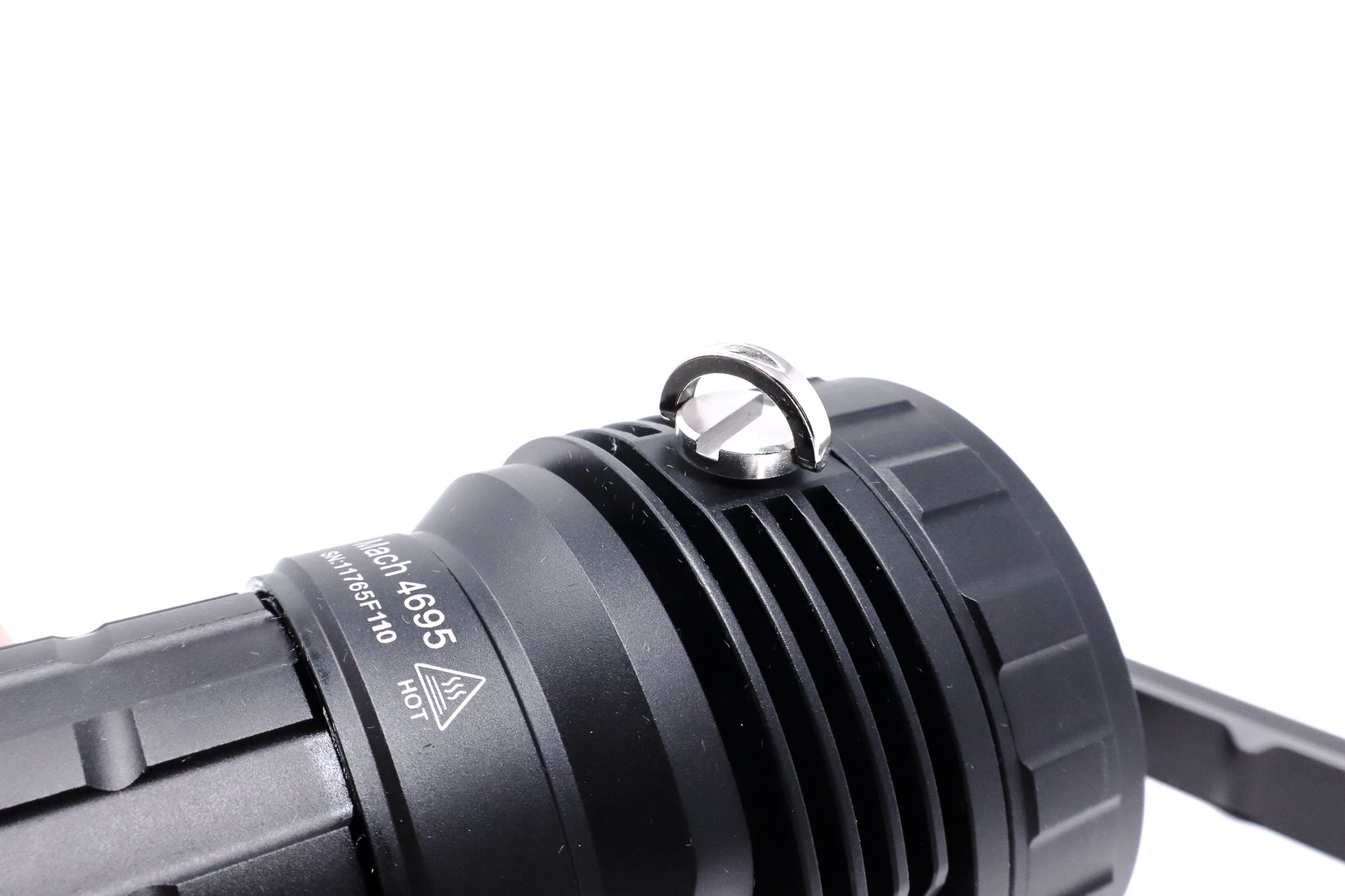
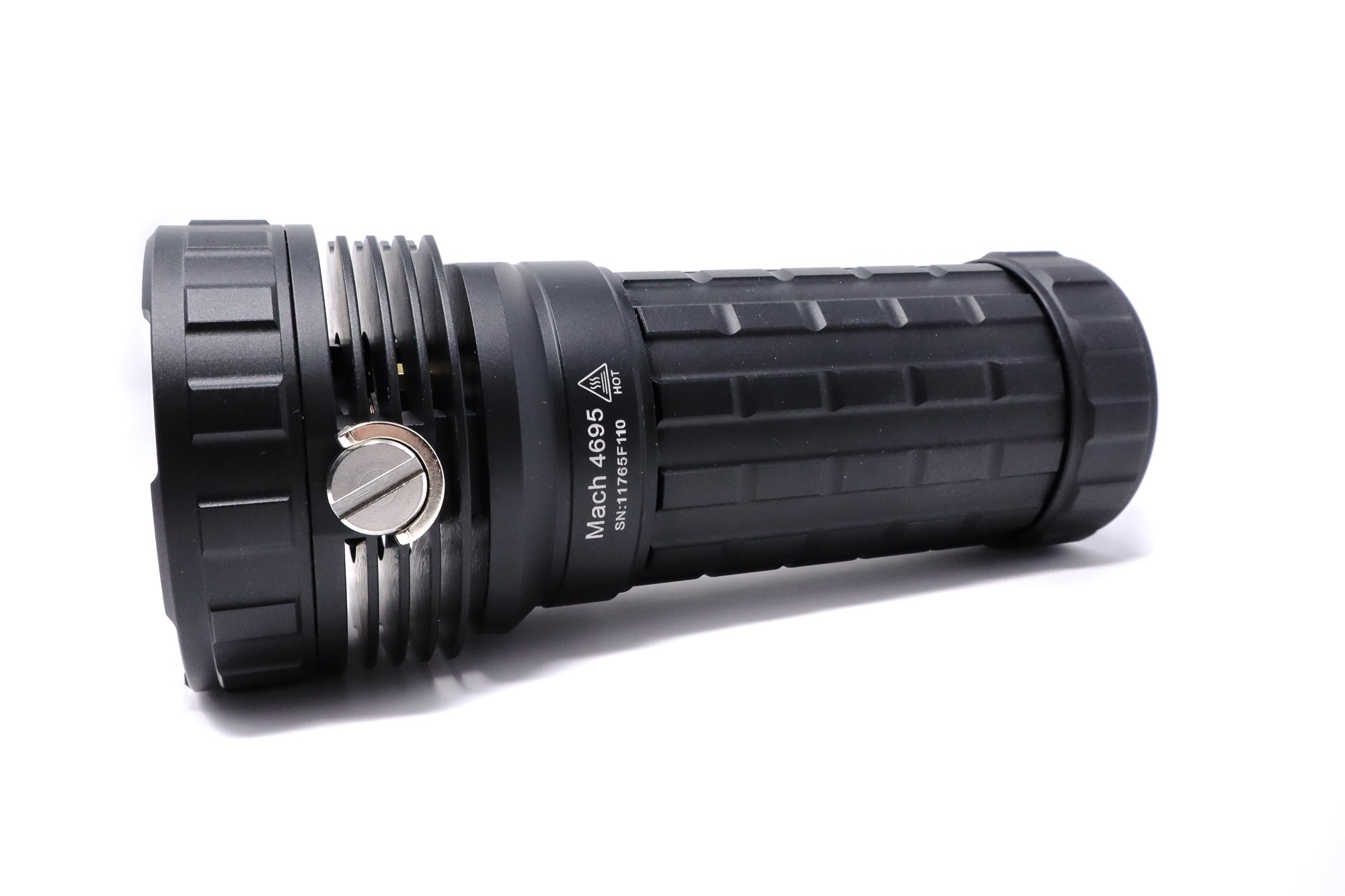
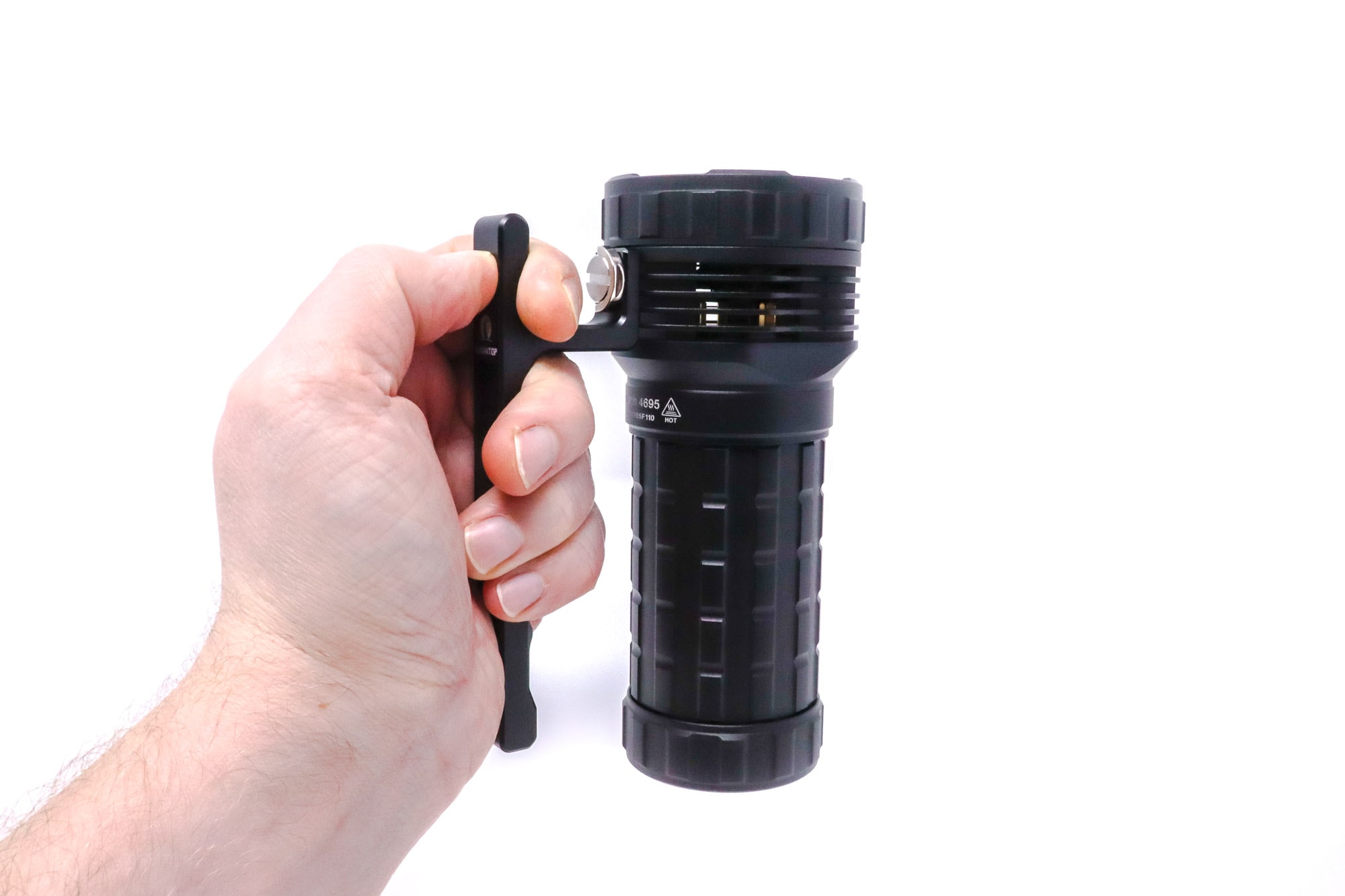
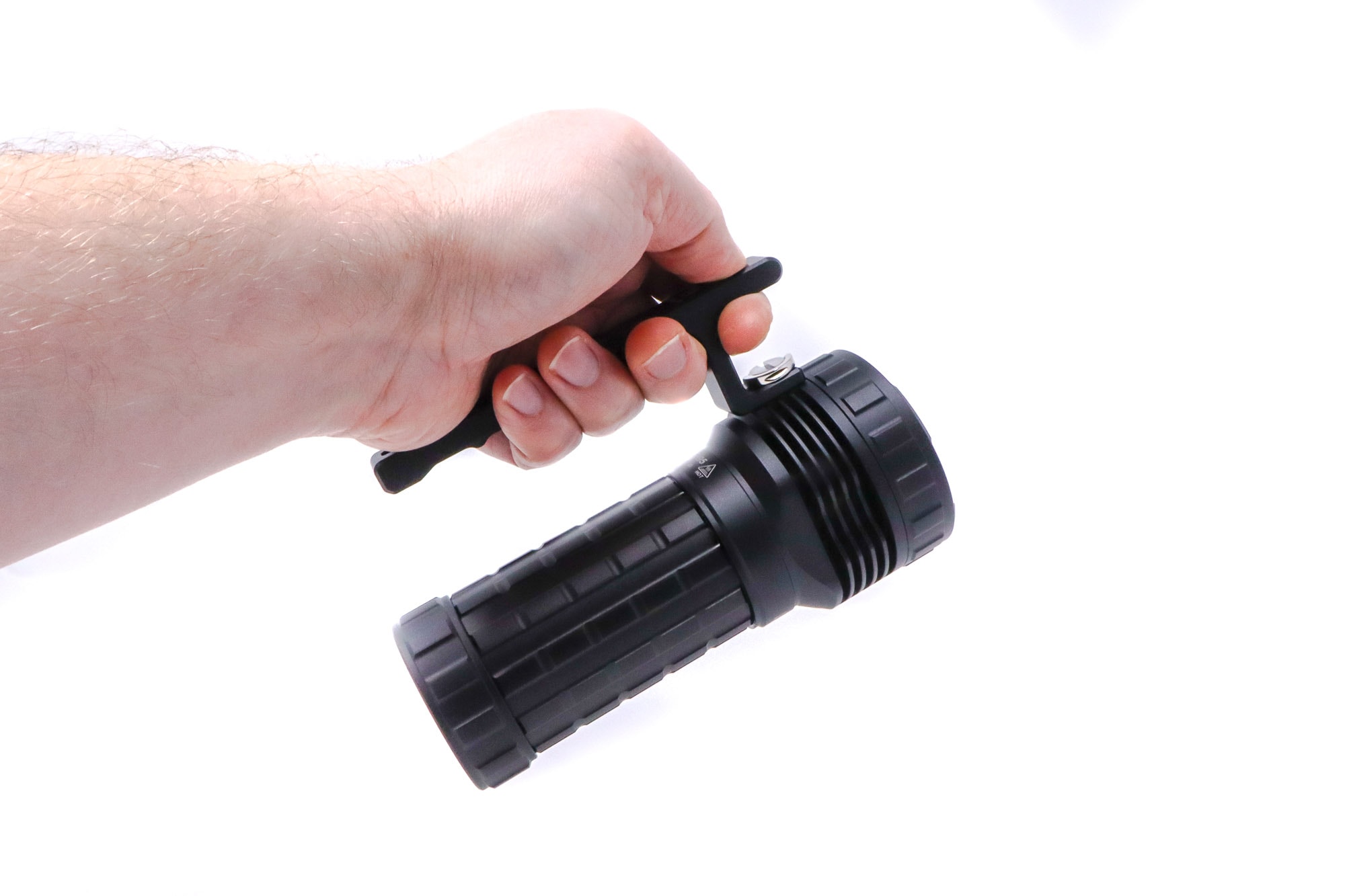
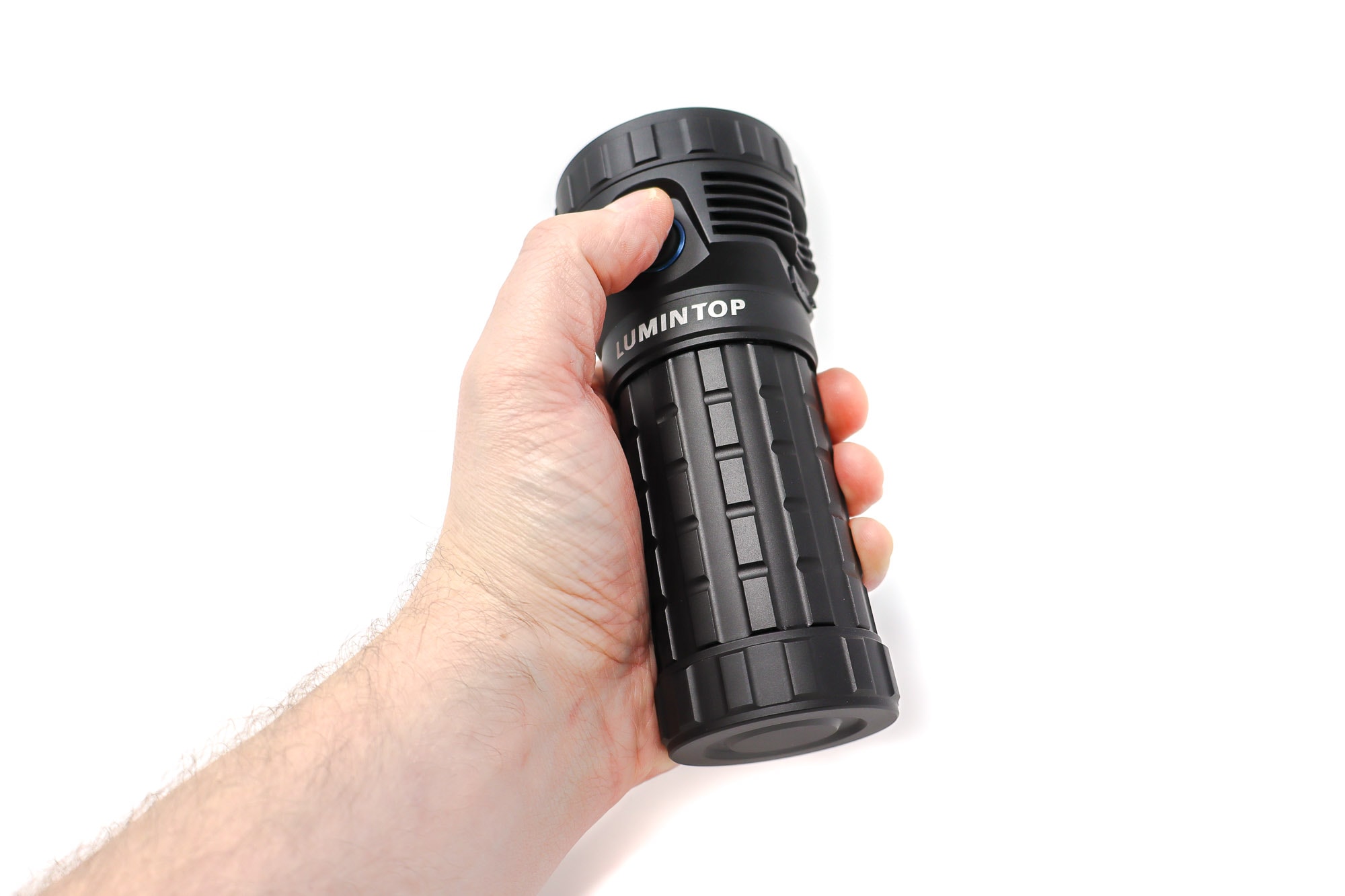
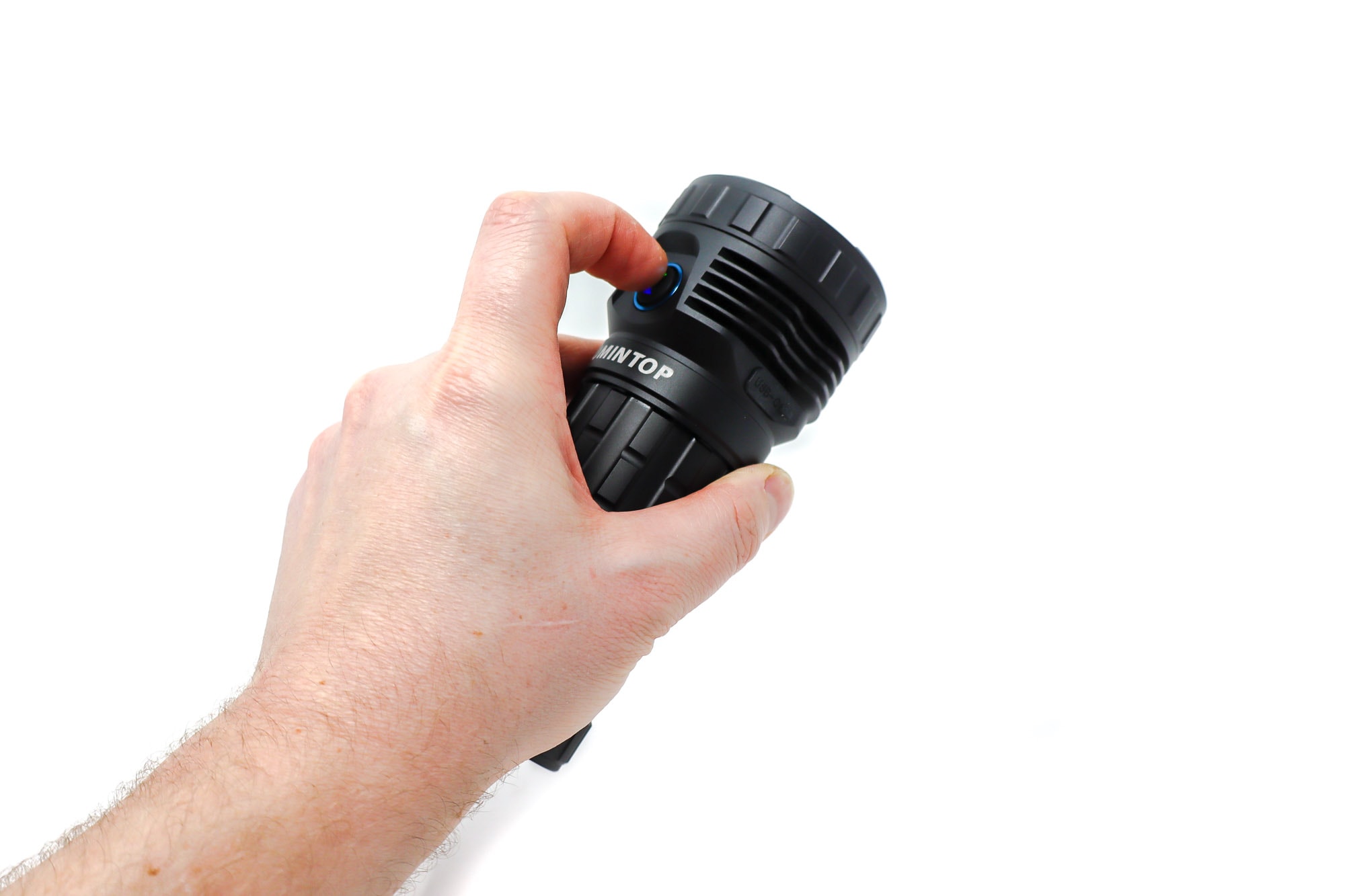
LED, Lens, Bezel, Beam, and Reflector
The Mach V2 enlists the same eight Cree XHP50.2 HD LEDs as the V1 Mach. There’s really no need to change these since I’m sure Lumintop wanted to maintain the high output. Cree LEDs are superior to the San’an analogues in efficiency and output, so I’m glad there still here. The XHP50.2 HD is a domed, quad die high output 3 volt LED we’ve seen in tons of high output lights going back to 2017.
Even though the 50.3 is out, the gen 2 is a great LED: Efficient with a low thermal resistance, and you can run it off 3, 6, or 12 volts. It’s a flip chip CSP design with bond wires under the LES. It’s capable of very high output. It’s CW only here. The reflector is the same: An 8-cup OP unit with shallow reflectors arranged radially with a central air intake for the cooling fan. The intake grille has been changed a bit, maybe to let in more air? Who knows.
The beam is all flood, but has surprisingly good beam distance. There’s a somewhat discernible hotspot, and it does have the angular tint shift common to domed XHP products. The tint isn’t at all unpleasant, but does shift positive duv, but it isn’t noticeably green here.
Spectral measurements:
I used the Opple Lightmaster Pro to measure the flashlight at 1 meter from the sensor.
| Mode: | CCT: | CRI Ra: | duv |
|---|---|---|---|
| Turbo | 5343K | 62 | 0.0106 |
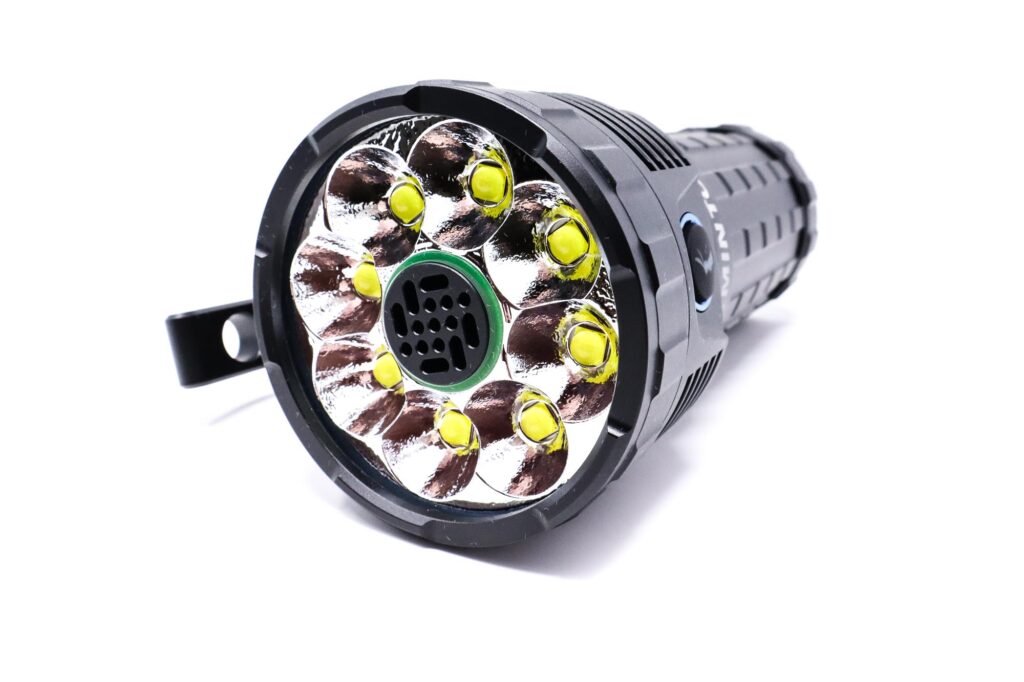
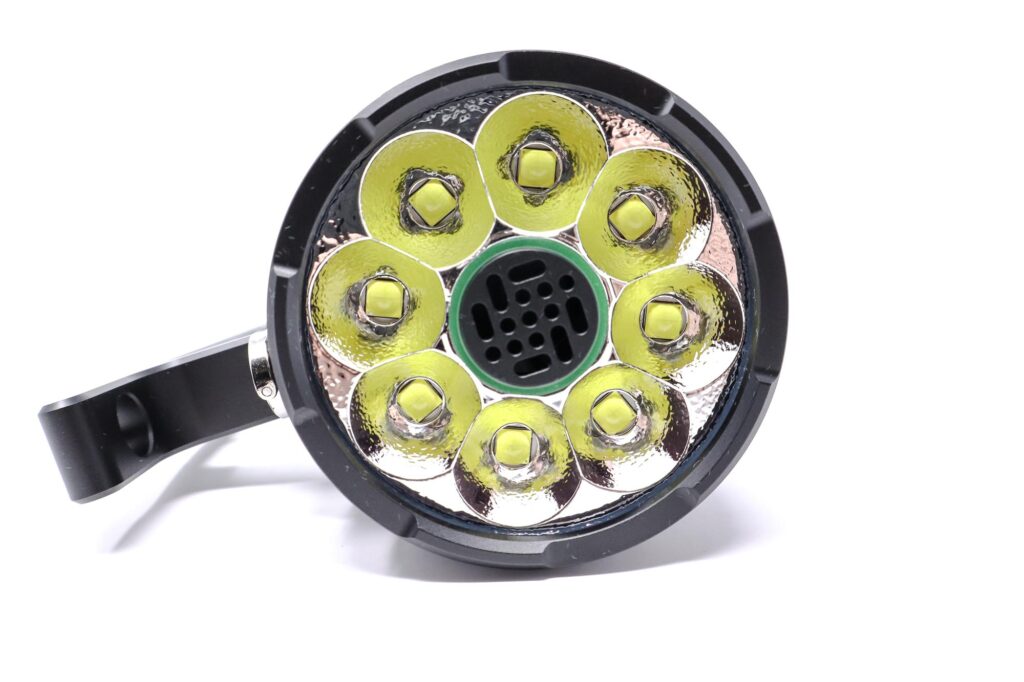
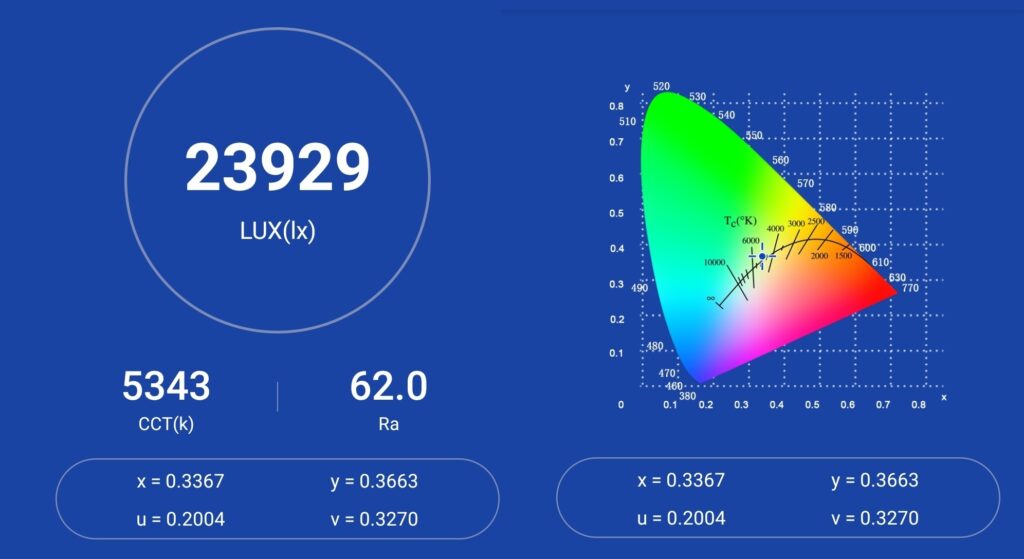
Dimensions and its competition
Dimensions:
The Mach V2 is slightly longer than the Mach V1, even though that light had a fancy I/O panel for charging on the back of the tube.
| Lumintop Mach 4695 v2 | Millimeters | Inches |
|---|---|---|
| Length | 155 mm | 6.1 in |
| Head diameter | 68 mm | 2.7 in |
| Body diameter | 51 mm | 2 in |
Dimensions are rounded to the nearest millimeter and the nearest tenth of an Inch.
Weight:
The Mach V2 is a heavy flashlight and it’s over 100 grams heavier than the Mach V1 fully loaded, with the handle.
| Lumintop Mach 4695 v2 | Weight in grams | Weight in oz |
|---|---|---|
| Without battery or handle: | 392 g | 14 oz |
| With battery and handle | 863 g | 30 oz |
Weight is rounded to the nearest gram and tenth of an Oz.
Flashlight size comparison with its competition:
Group 1 left to right high power flashlights: Amutorch DM80, Lumintop Mach V1, Lumintop Mach 4695 V2, Lumintop Thanos 23, Ripsshine HF1
Group 2 left to right: Wurkkos TS32, Fenix LR60R, Lumintop Mach 4695 V2, Sofirn SP36 Pro
Group 3 reflectors left to right: Lumintop Mach, Ripsshine HF1, Lumintop Mach 4695 V2
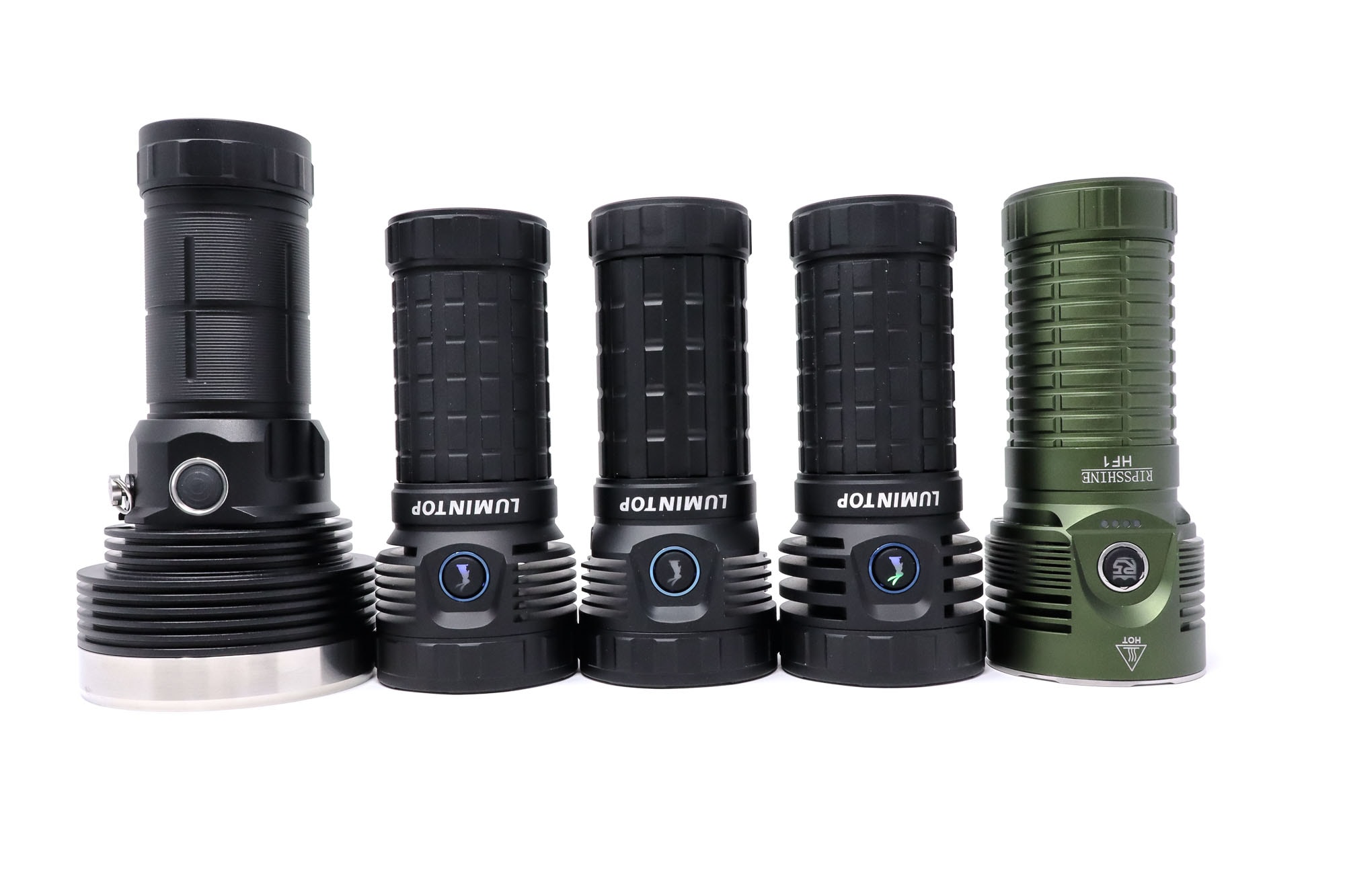
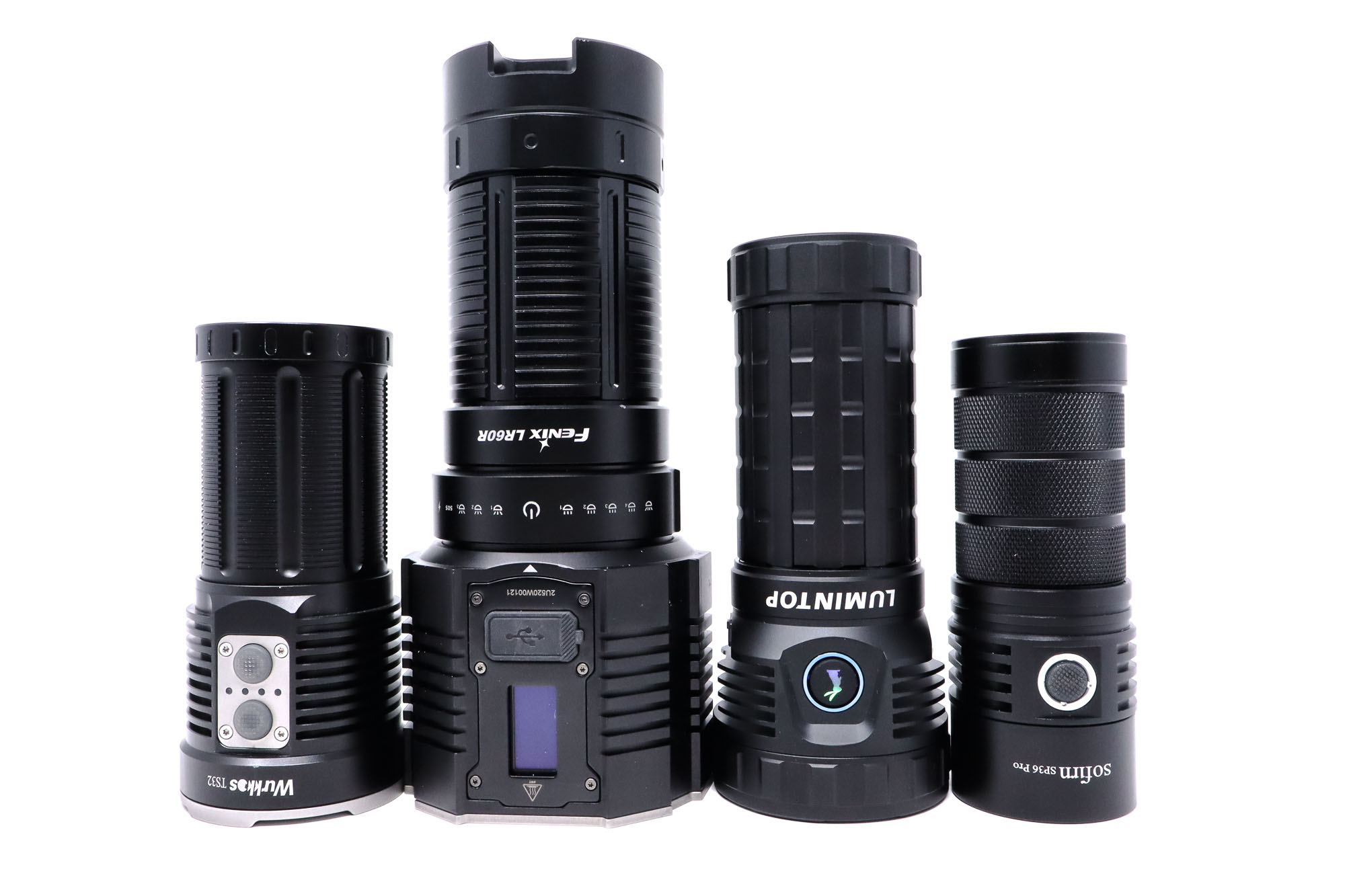
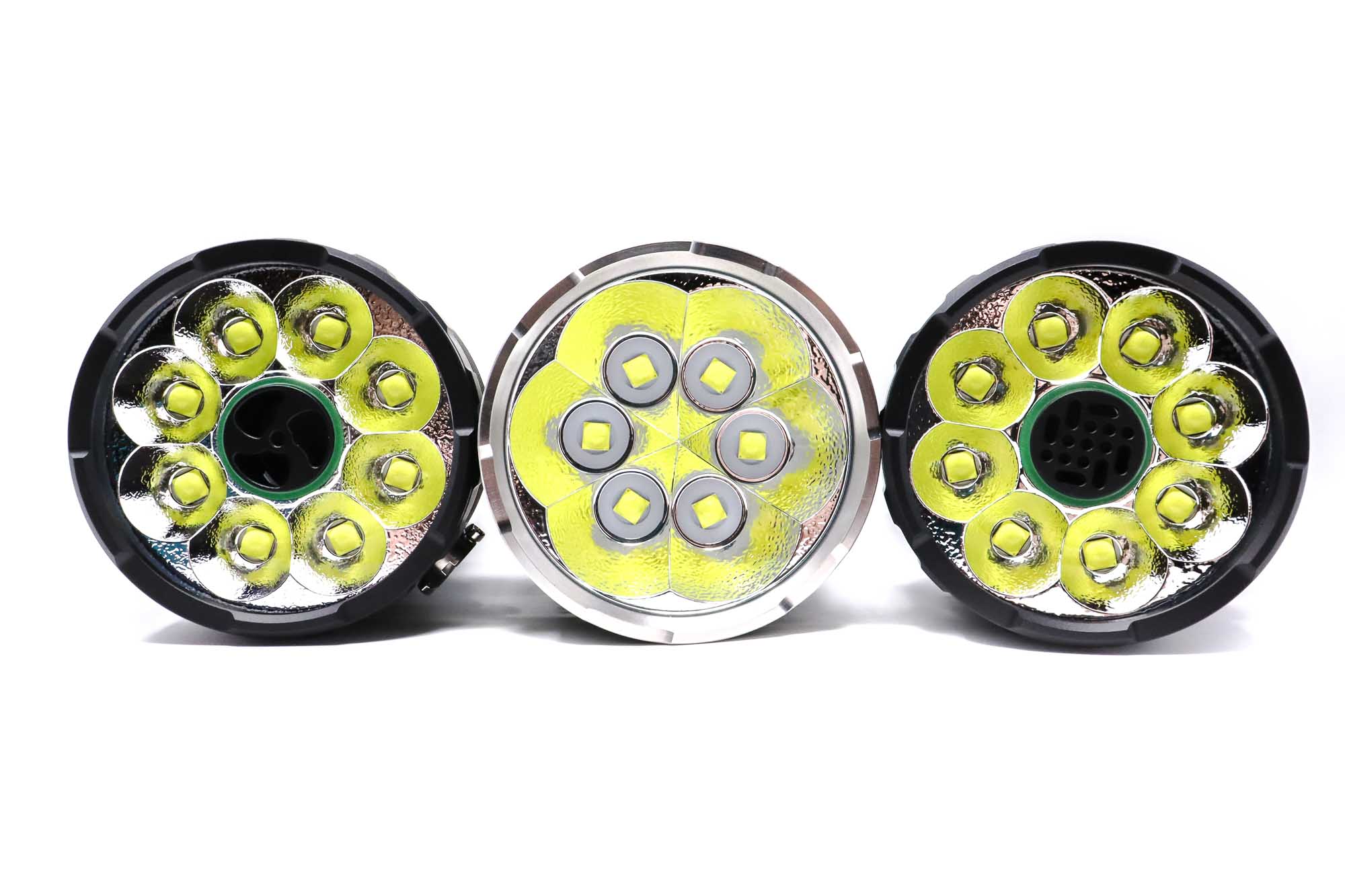
Lumintop Mach 4695 v2 UI: User Interface and Driver
The driver is unchanged from the V1, so it’s going to be a FET driver with a 7135 regulator for low and moonlight modes and a MOSFET for direct drive. The only other competitor to this light is the Ripsshine HF1, and that one has a superior, fully regulated buck driver.
The UI is also unchanged from the V1, and it seems Lumintop is unapologetic to all the Anduril fans out there since this light still doesn’t have Anduril or Anduril 2. That’s not a bad thing at all, since the Mach’s UI was totally fine and well-suited to it. It’s a ramping UI with 4 modes, Moon, plus blinkies, and adds niceties like batt check, electronic lockout, and switch LED control.
Available modes:
- Smooth ramping with Moonlight, High 1 (top of ramp), High 2, Turbo
Available blinky modes:
- Strobe, SOS, Beacon Flasher
From OFF:
- Press and hold: Moonlight (double click in Moonlight for Strobe)
- Single click: Turns on in last memorized brightness level (only levels up to High 1 are memorized)
- Double click: High 2. To activate Turbo, double click while in High 2.
- 3 fast clicks: Battery check. Like with Anduril, the light blinks out the battery voltage, e.g. four blinks, a pause, and a single blink is 4.1 volts, three blinks, a pause, and eight blinks is 3.8 volts.
- 4 fast clicks: Electronic lockout
- 5 clicks turns turns fan on or off
- 7 clicks: Turns switch LED on or off
From ON:
- Press and hold: Ramps brightness up
- 1 click: Turns off
- Double click: High 2
- To activate Turbo, in High 2, double click the switch again
Mode memory:
- Remembers last brightness level up to High 1 (top of the ramp). Moon, High 2, Turbo and blinkies are not memorized
Shortcuts:
- To Moon: From off, long press switch for 1 second
- To Turbo: 2 clicks when in High 2 mode
- To Strobe: In Moonlight, double click to activate Strobe. To cycle through SOS and Beacon, double click again for each mode
Low voltage warning/protection:
- The light will drop to a very low level when the batteries reach a certain low voltage (not specified in the manual)
Strobe/blinkies
- Strobe, SOS, Beacon Flasher
Lock-out mode:
- Electronic lockout. From off, click the switch 4 times to activate lockout. Momentary Moonlight mode will be available in lockout. To deactivate lockout, repeat the 4 clicks.
PWM
- Fast PWM not visible to the naked eye
Additional/summary info on the UI:
- Again, this is the same UI as the Mach V1. I liked it on that light, and I like it on this one. I enjoyed the smooth ramping, and while not as nice as Anduril’s level of precision and smoothness, it strikes a bit of an in-between.
- The fan control is present like the V1, and it’s very useful in cases where a noisy fan might not be welcome, or if you want to save energy and not run the fan. To turn on/off the fan, click 5 times from off. A blue LED in the switch will turn on when the fan is on, and goes away when the fan is deactivated.
- Lumintop says the fan is temperature controlled and comes on in Turbo mode (continuously), and when the temperature reaches a certain threshold on High 2. The fan should turn off when the temperature drops.
Lumintop Mach 4695 v2 Charging and batteries
Here’s where the V2 differs from the V1. The V1 had the typical soda can 3×21700 configuration in parallel for power, but the V2 ditches those and goes with the baddest battery to grace the flashlight world in the past decade: The 46950 li-ion. The included cell is Lumintop-branded and yes, it’s ‘customized’ (aka proprietary) with the anode and cathodes on the top (the bottom has an isolator).
This is a monolithic cylindrical 4.2 volt lithium ion cell originally designed for electric cars, but found its way into flashlights. It’s 46 mm wide, 95 mm long and typically has around 32,000 mAh or up to 118 Wh. These can support serious current loads (some have said up to 900 watts) and charge rates also, and are perfectly suited to high output, multi-LED flashlights. The highest capacity 21700s are pushing close to 6 Ah, so you’d need 6 of those to best the 46950.
For charging, the Mach V2 uses a USB type C for the input/output (power bank) at QC2.0/3.0 speeds with PD up to 12v 1.5 amps on the charging and 9 v 2 amps on the output (18W). On my Hidance USB C tester, I saw about 18 watts max for charging on a 45W wall wart, and 18W for the power bank. It’s not slow, but I think it should be higher. Hey Lumintop, can we get 45W PD charging for this? It took about 10 hours to recharge the cell after a runtime, and the termination voltage was 4.18 volts. My USB meter quits measuring at 12,000 mAh, but keeps measuring the accumulated electrons. I usually saw between 110 and 120 Wh added to the cell.
| Charge type | Fits | No fit | Charge time |
|---|---|---|---|
| Flashlight with onboard USB-C | 46950 only | Every other li-ion | About 11 hours to add 120 Wh |
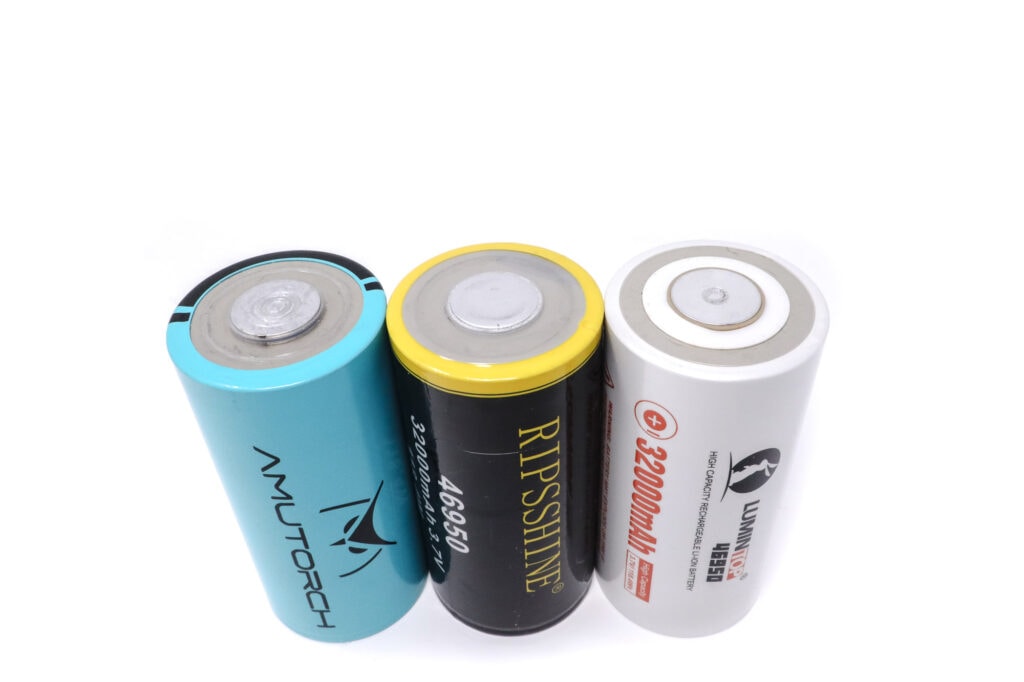
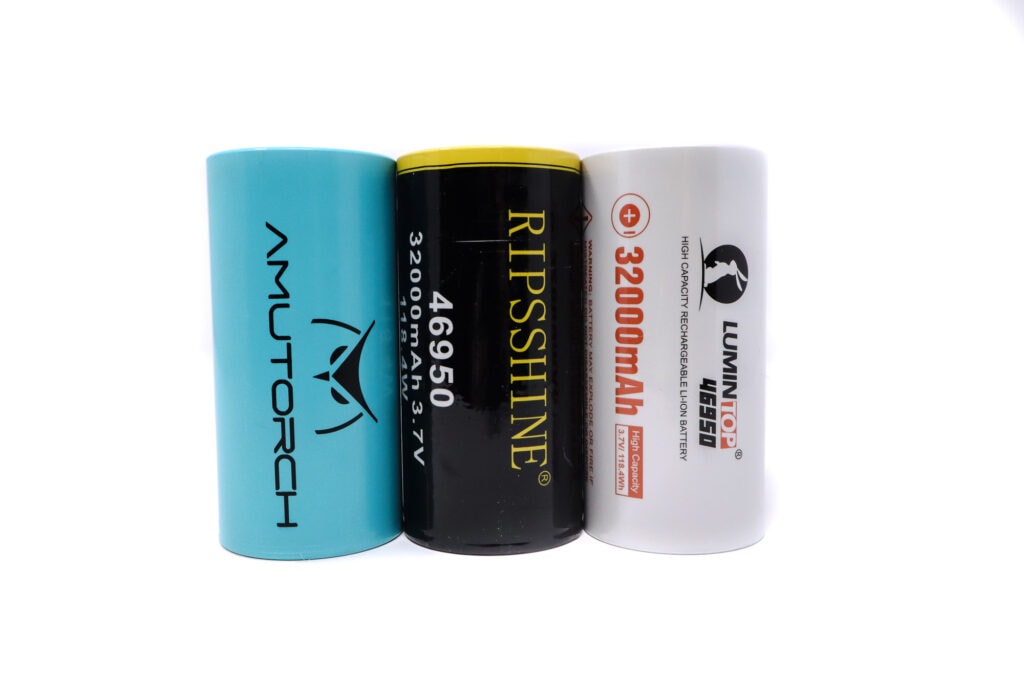
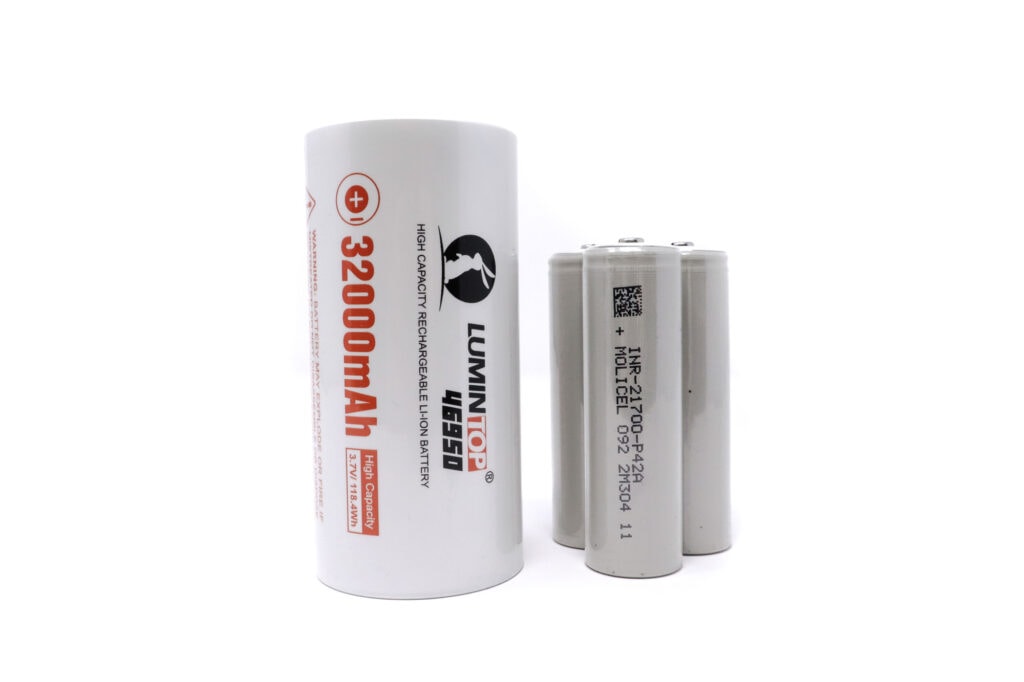
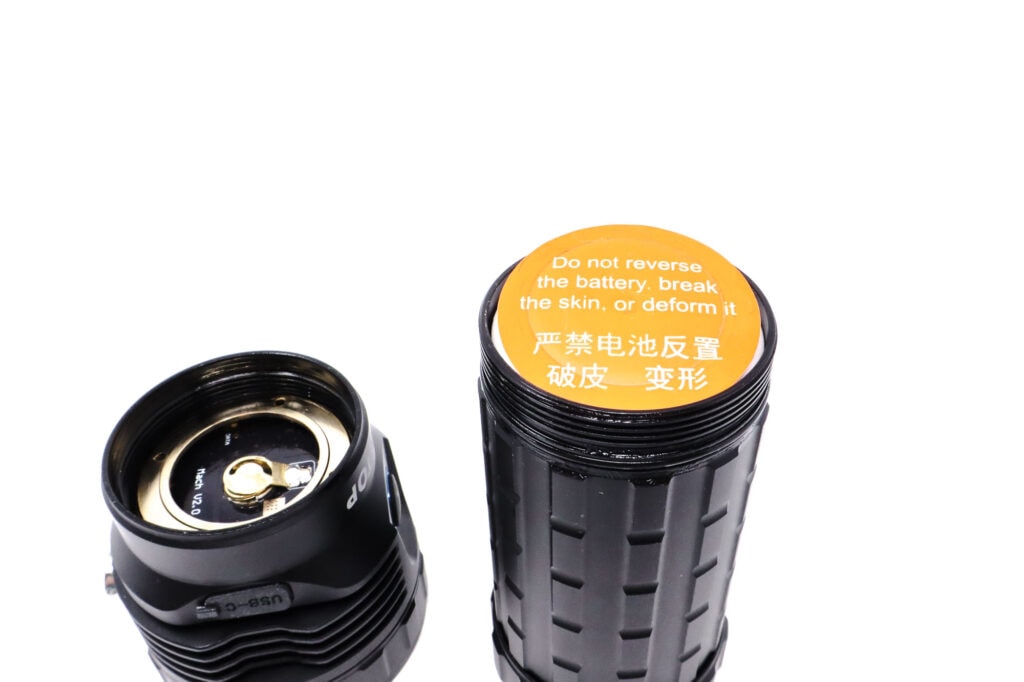
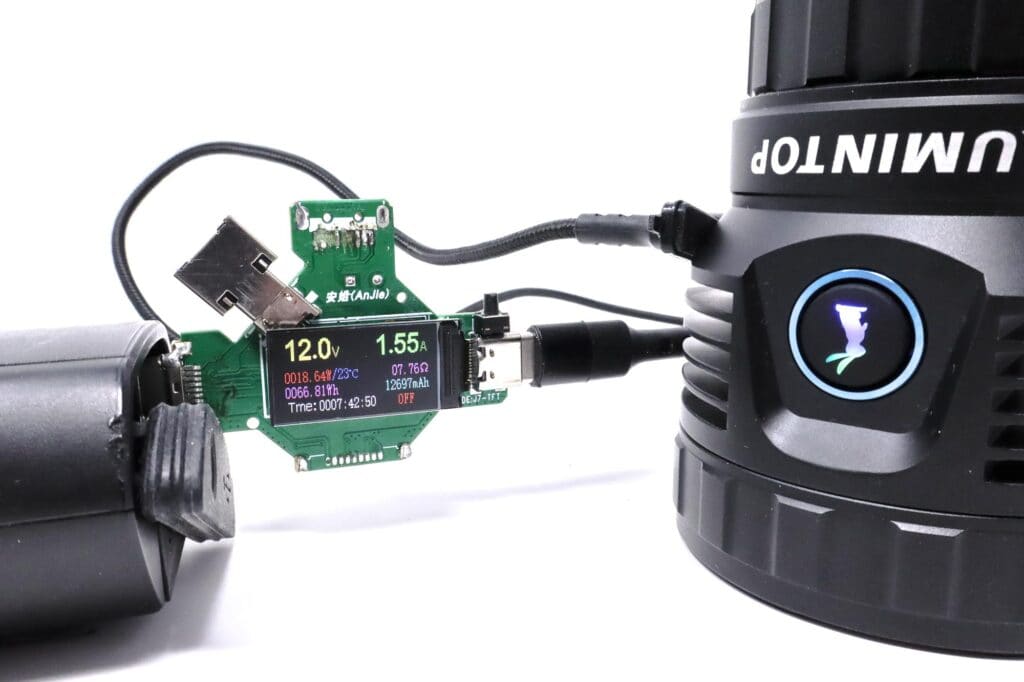
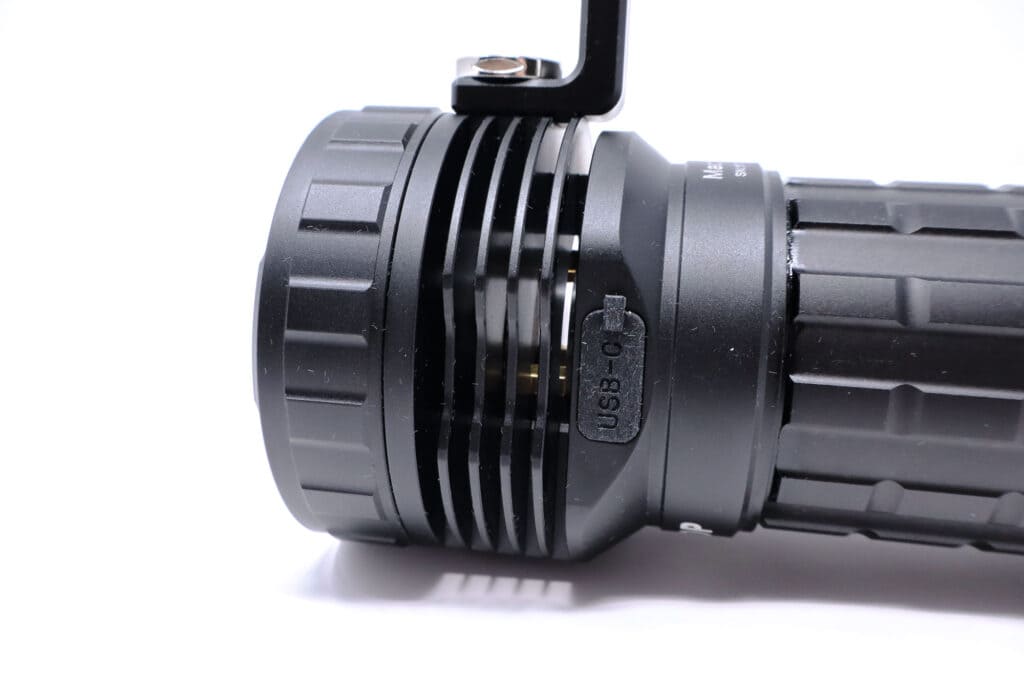
Performance test
Lumen measurements
How Lumens are Measured: Understanding ANSI FL1 Standards How Lumens are Measured: Understanding ANSI FL1 Standards: The ANSI FL1 standards specify that output in lumens should be measured 30 seconds after turning on, as this is the standardized time for measuring brightness according to the industry standard. This is why we focus on this part in our measurements. The ANSI FL1 standards require an ambient temperature of 22 ± 3°C. We record the ambient the ambient temperature to identify potential reasons for any observed discrepancies.Lumens are measured in my 50 cm integrating sphere with a Digi-Sense 20250-00 data logging luxmeter. The sphere has been calibrated with a Convoy S2+ measured to 260 Lumens and the figures are within 10% of actual. No current measurements this time due to the (mostly) inaccessible current path. I usually don’t test current on soda can lights due to the risk of shorting something and releasing the magic smoke.
| Mode | Specified | Turn on | 30 sec. | 10 min. |
|---|---|---|---|---|
| Moon | 1 | – | – | – |
| High 1 | 2500 lm | 2337 lm | 2337 lm | 2337 lm |
| High 2 fan on | 8000 lm | 7134 lm | 7011 lm | 6519 lm |
| High 2 fan off | ? | 7257 lm | 7134 lm | 2337 lm |
| Turbo fan on | 26,000 lm | 23,247 lm | 18,573 lm | 6396 lm |
| Turbo fan off | ? | 23,985 lm | 20,664 lm | 2337 lm |
Ambient temperature during testing:
- 18.9°C
Parasitic drain:
- N/A µA/mA
I’m coming in below the advertised specs by a lot here, so the bigger battery didn’t do much to help the raw output. The fan is thermally controlled, coming on at around 55 C on High 2, and turns on immediately when Turbo is activated. As expected, the fan does a lot to help hold the output by the 30-second measurement for ANSI and at 10 minutes.
Lumintop Mach 4695 v2 Battery Life: Runtime graphs
How Runtimes are Measured: Understanding ANSI FL1 Standards About ANSI FL1 runtime standards: The runtime is measured until the light drops to 10% of its initial output (30 seconds after turning on). This does not mean that the flashlight is not usable anymore. The last column shows how long the light actually works till it shuts off. If there is a + symbol, it means that the test was stopped at that particular point, but the light was actually still running. This happens on certain occasions, with certain drivers, firmware, or batteries.Lumens are measured in my 50 cm integrating sphere with a Digi-Sense 20250-00 data logging luxmeter. The sphere has been calibrated with a Convoy S2+ measured to 260 Lumens and the figures are within 10% of actual. I use a Digi-Sense 20250-92 data logging thermocouple for the temperature measurements. The probe is affixed to the head using kapton tape and uses the same 5 second sampling rate for logging.
I measured High 1 through Turbo, with High 2 and Turbo run with and without the fan activated. The battery was allowed to fully charge before each test.
| Mode | Specified | Runtime (ANSI FL1) | Time till shut off |
|---|---|---|---|
| High 1 | 8h | 6h 45min | 6h 45min* |
| High 2 with fan | 2h 20min | 2h 24min | 2h 27min* |
| High 2 without fan | 7h 2min | 6h 23min | 6h 25min* |
| Turbo with fan | 2h 18min | 1h 37min | 2h 28min* |
| Turbo without fan | 7h | 50s | 6h 25min* |
*The light was still running at a very low level when the test was terminated.
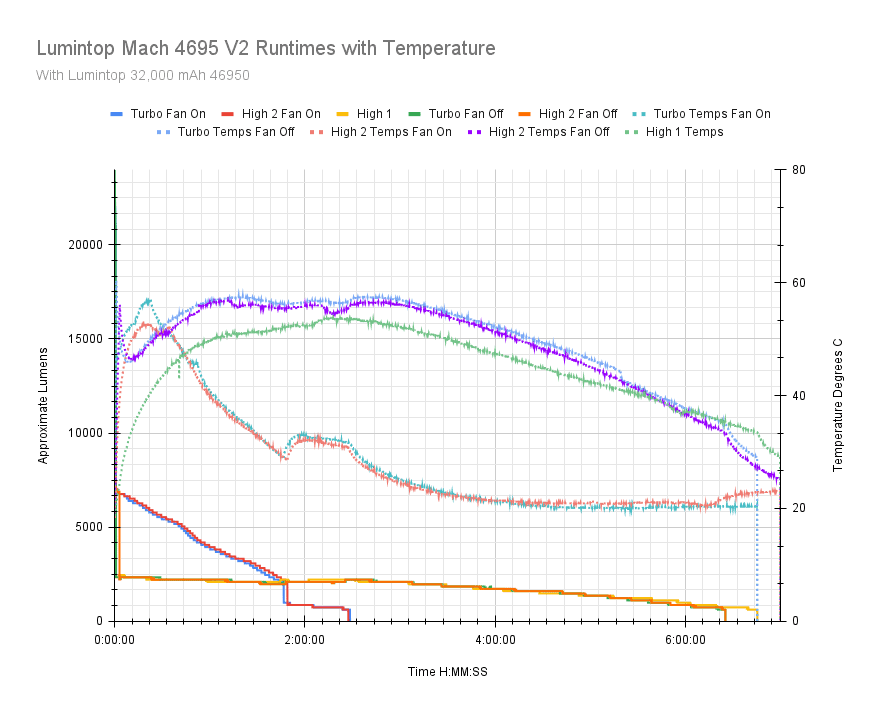
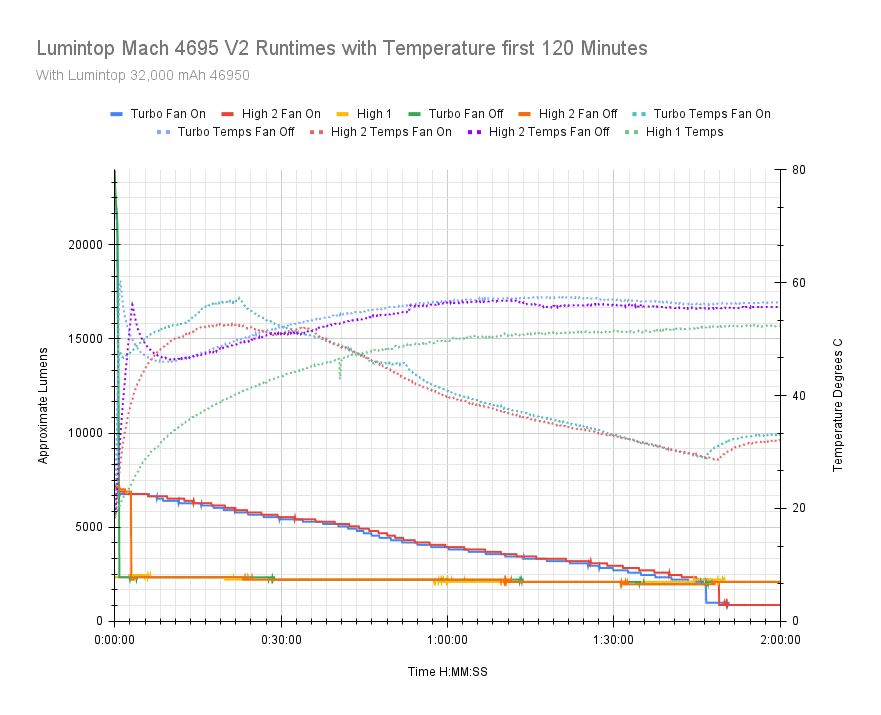
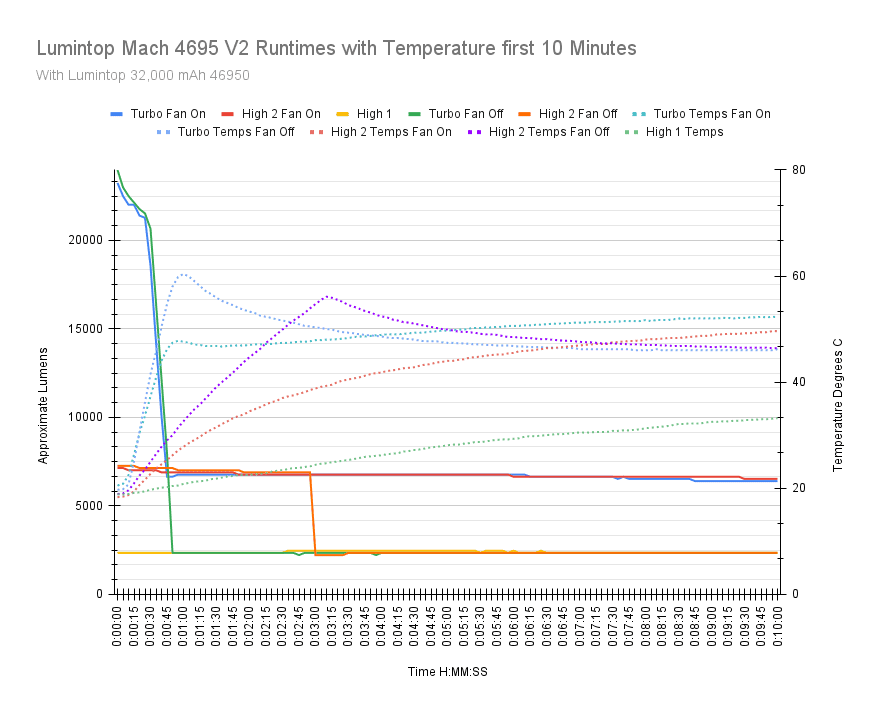
Bottom line: The fan does its thing and helps a lot. It comes on instantly for Turbo, and is active for High 2. It’s thermally controlled to automatically turn on/off and I found it kicks on around 55-60 C, and turns off around 46-48 C. It works just fine and keeps the temps down. The light was hand-friendly the entirety of the Turbo runtime.
Note Lumintop lists the step downs for the High 2 and Turbo modes for the fan on and fan off as 2 minutes for High 2 and 20 seconds for Turbo for no fan, and 45 seconds for Turbo with the fan (no step down for High 1 with the fan). The outputs for the fan-on modes tracked more or less identically after their step downs, with High 2 lasting a bit longer than Turbo. The fan-off runtimes tracked together as well, with the lower output mode running longer before the final step down.
The outputs all dropped down to a very low level for LVP, and ran like that until I terminated the testing. Comparing the Mach V2 and V1, the increase in runtime is significant. The Mach V1 peters out at 50 minutes on Turbo with the fan, and High 2 lasts 52 minutes. Even the fan-off runtimes are extended. A lot. Across the board, it’s a more than 50% increase in runtime for the big battery.
Looking at the comparison graphs, the only competitor in my arsenal to the Mach V2 is the Fenix LR80R. For a $200 flashlight, this is awesome performance!
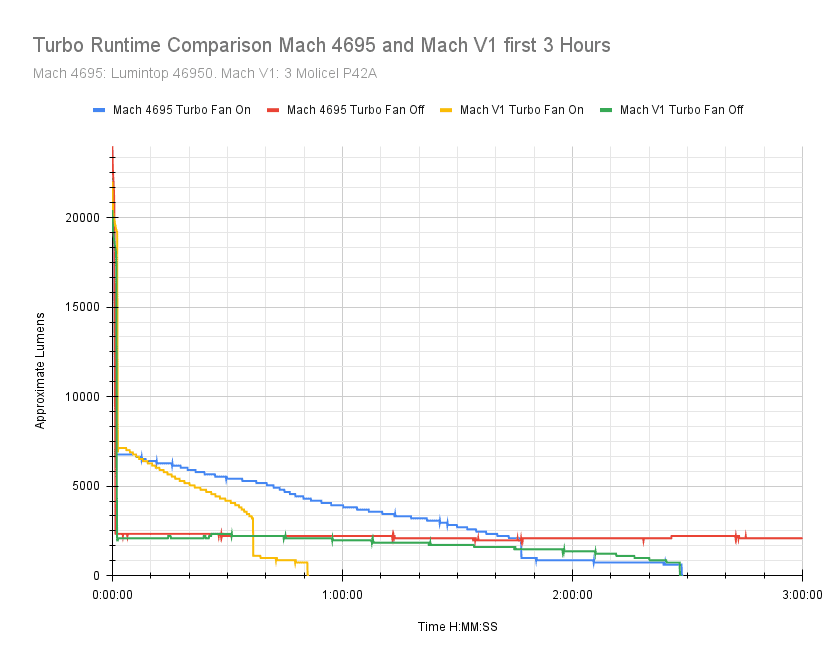
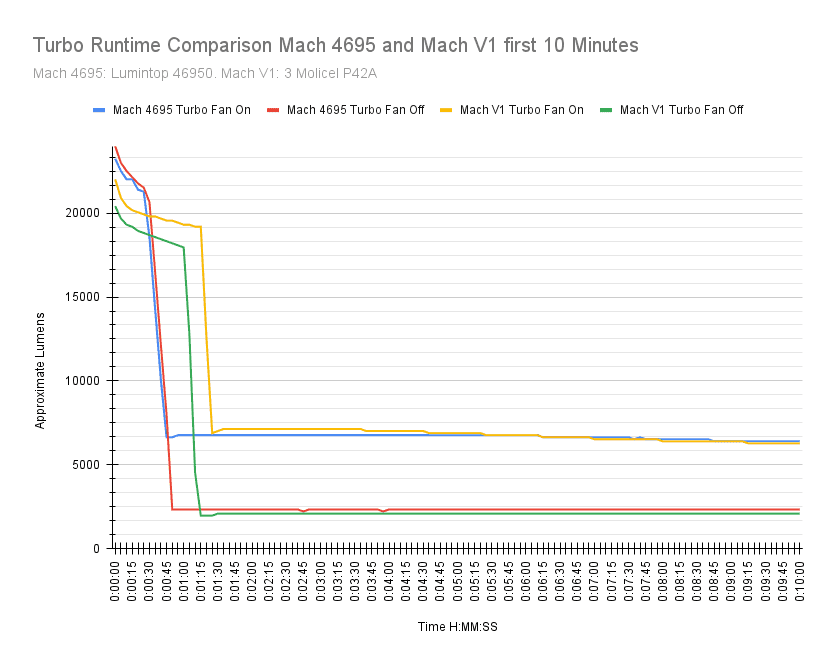
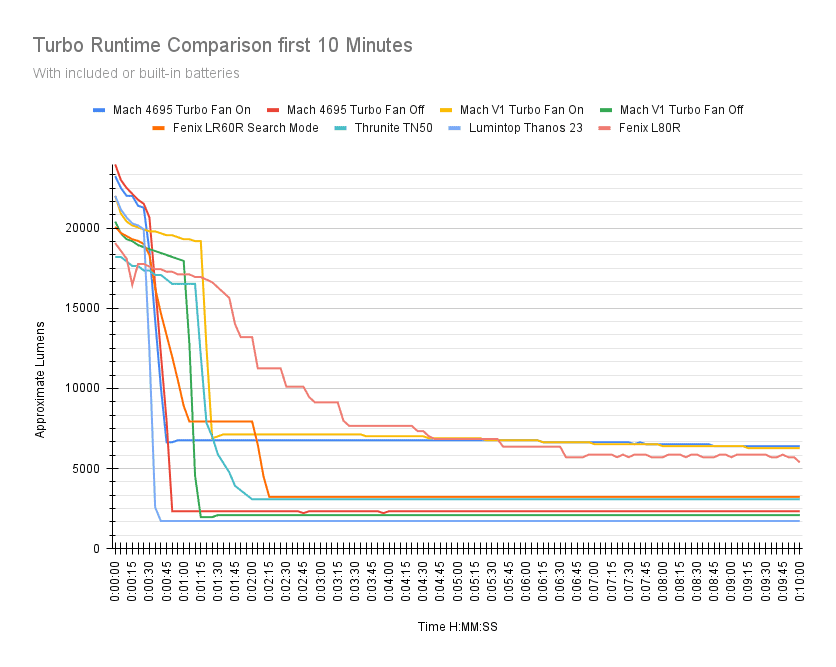
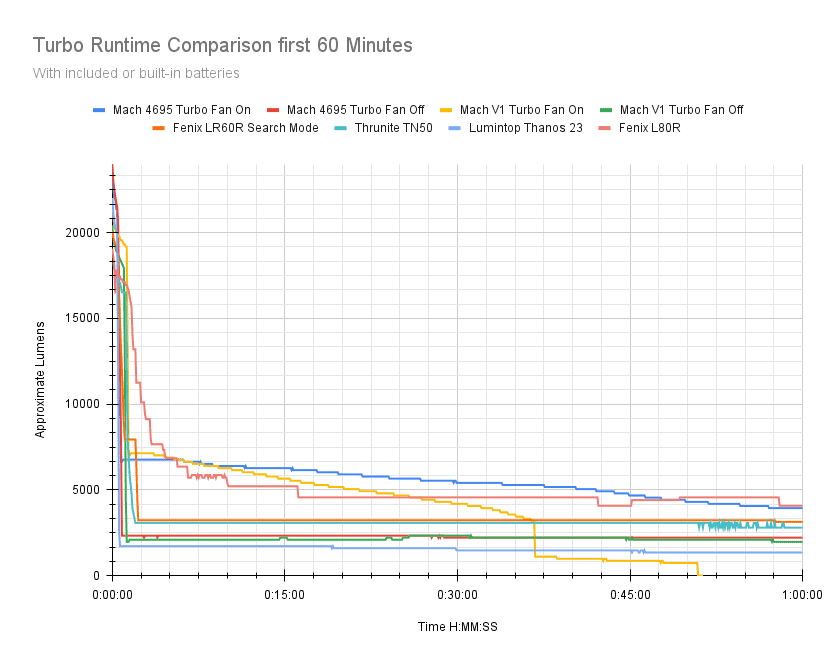
Peak beam intensity and beam distance measurements
About Peak beam intensity: Understanding ANSI FL1 Standards About peak beam intensity The calculated value of distance in meters at which the flashlight produces a light intensity of 0.25 lux. (0.25 lux is about the brightness of a full moon shining on an object). This means that the intensity has decreased so much, it becomes difficult to see darker objects, or objects that don’t reflect light. The columns ‘Meters’ and ‘Yards’ use rounded numbers.Beam distances are measured using a Uni-T UT383S luxmeter measured indoors at 5 meters using the included fully charged 46950 battery. Measurements taken at 30 seconds. I ran High 2 and Turbo with and without the fan, and the light was recharged and allowed to cool between the High 2 and Turbo fan on/off tests.
| Mode | Specified | Candela measured | Meters | Yards |
|---|---|---|---|---|
| Moon | ? | N/A | N/A | N/A |
| High 1 | ? | 7,225 cd | 170 | 186 |
| High 2 with fan | ? | 23,750 cd | 380 | 416 |
| High 2 without fan | ? | 35,325 cd | 376 | 411 |
| Turbo with fan | 67,500 cd | 49,500 cd | 442 | 483 |
| Turbo without fan | ? | 49,500 cd | 442 | 483 |
| Turbo at turn on | ? | 74,950 cd | 548 | 599 |
Ambient temperature:
- 19.1 °C
Lumintop only lists a single candela spec for the beam distances. I assume it’s for Turbo, and I got more than that at turn on, but at 30 seconds, I’m coming up short even with the fan on. In fact, fan on/off made no difference at ANSI. Moon was too dim at 5 meters to register on the luxmeter.
Beamshots
Camera settings and distance: Photos taken with a Canon EOS R100 with Canon RF-S 18-45 mm STM lens. The camera is set to 0.3s, F5 ISO1600 and 5000K WB. The fence is 95 meters away.
Beamshots of the following flashlights compared:
- Lumintop Mach 4695 V2
- Lumintop Mach V1
- Lumintop Thanos 23 (flood+spot)
- Fenix LR80R
- Fenix LR60R (flood+spot)
- Amutorch DM80
- NEXTORCH Saint Torch 30C
Please note that the following beamshots are mainly intended to showcase the beam pattern and beam quality, rather than overall performance. These images are typically taken directly after activation, and in different seasons or weather conditions, and therefore do not fully represent its overall performance. For accurate performance metrics, such as output, beam distance, and runtimes, you need to look at the performance section of this review.


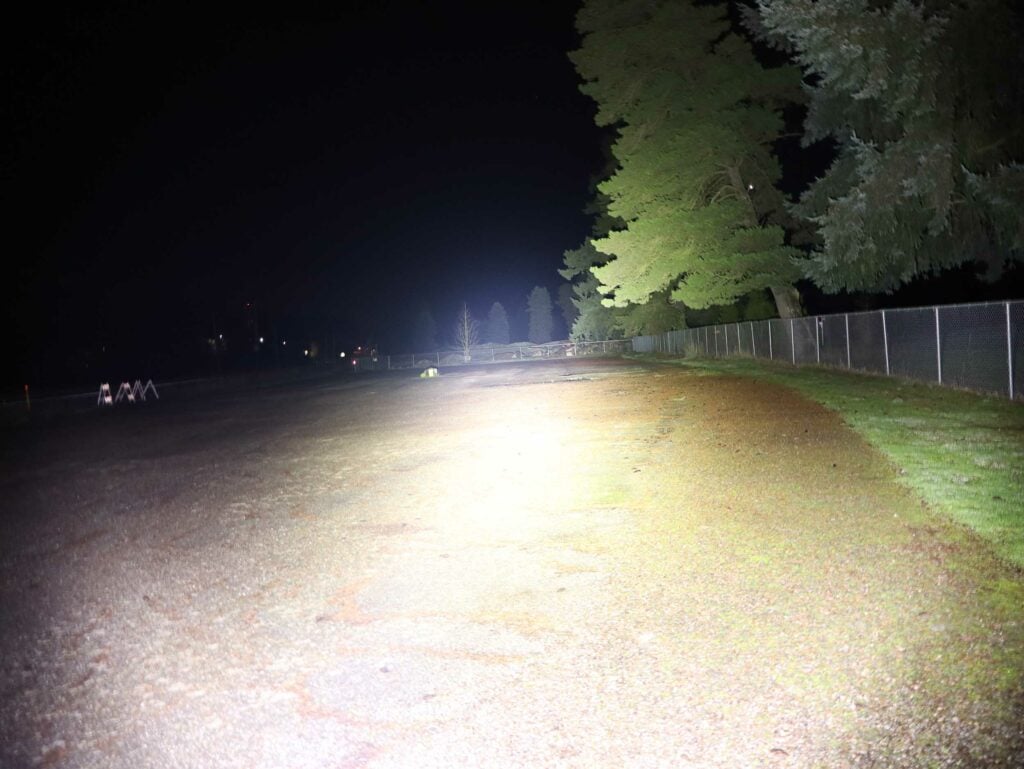
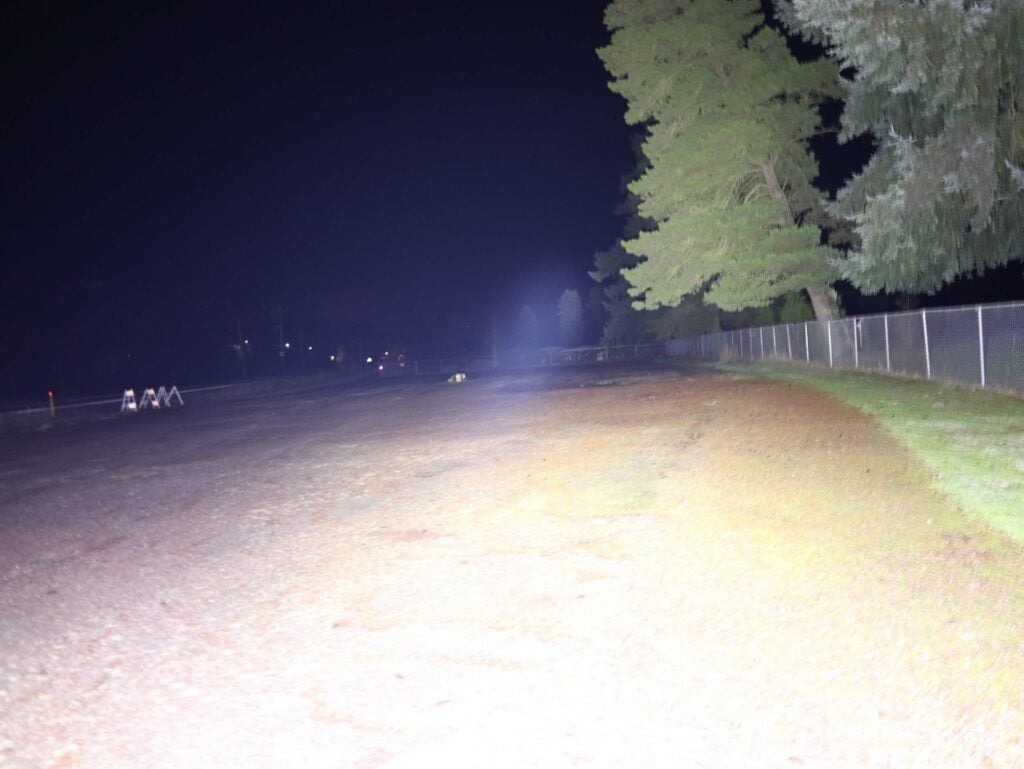
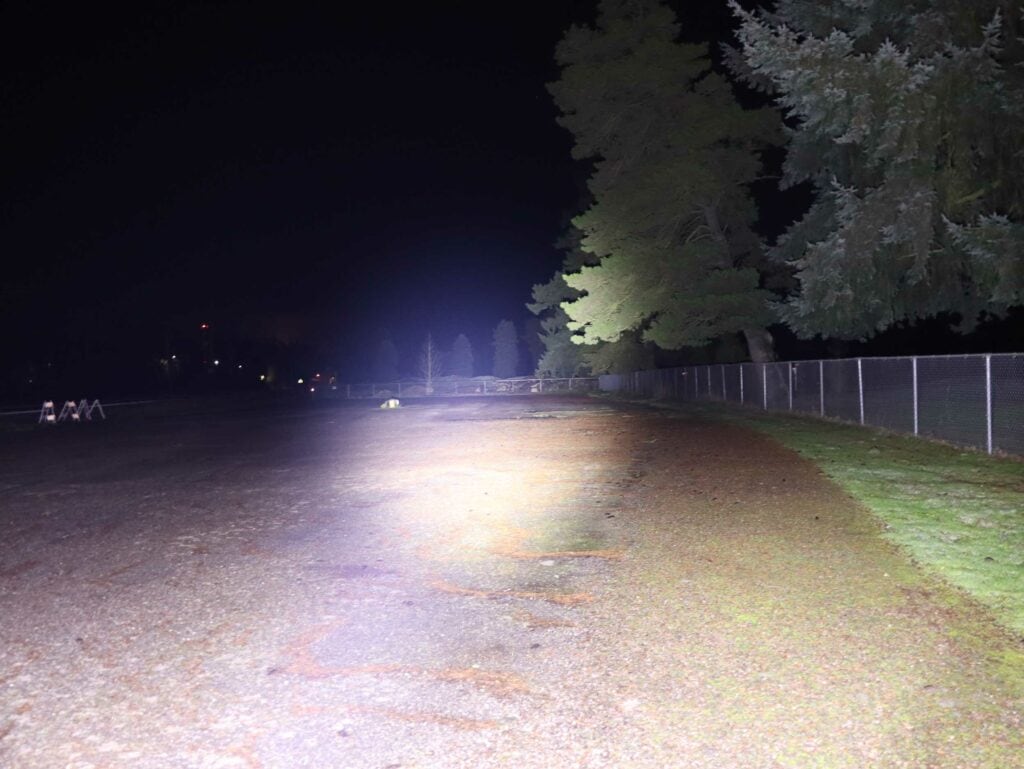


Disclaimer: This flashlight was sent to us for review at no cost by Lumintop. We have not been paid to review, nor have we been holding back on problems or defects.
Final Verdict
Pros
- Very affordable
- Great sustained output
- Vastly improved runtimes
- Onboard USB C charging
- Simple UI
Cons
- Charging could be a bit faster
- Didn’t meet output specs
- 46950 battery is hard to source
Explanation on star ratings:
1: Avoid: a match would be a better choice – 2: Poor: significant defect or issues; almost unusable – 3: Average: some defects or issues; but still usable 4: Good: recommended (minor issues) – 5: Great: highly recommended

4.5 stars: ★★★★⋆
While our star rating provides a reliable indicator, we encourage you to read the full review to make an informed decision based on your own needs and preferences.
I came away mighty impressed after testing the first Mach. It was pretty revolutionary, packaging the fan completely internally (while being fully immersible) and had fantastic sustained output for a relatively compact soda can light. At the time, no other sub-$300 flashlight could touch the Mach for sustained output, but the runtimes were a bit of a letdown (sort of expected).
The Mach V2 improves on the V1’s runtimes a lot, but still stays within the $200 range while maintaining the same easy handling and great UI. This new light doesn’t do much output-wise, but it’s in the runtimes where it shines. Now, it’s not perfect, but pretty close!
The charging could be a bit faster with 20v at 2.5 amps to bring that 11 hours to full charge down to 4 or 5, and the output specs were still…optimistic. It’s also quite a bit heavier than the first Mach due to the larger battery. I won’t knock the V2 for the proprietary battery since it’s pretty much the only way we can get these (probably a result of them being designed for EVs, not flashlights), but the fact that you can only use it for the light could be a potential issue. These are pretty new cells and hard to source if a replacement was needed.
Even still, I have no problem recommending the Mach V2 for someone who wants a compact light that can maintain high output with long runtimes. 4.5 stars for the Mach 4695 V2.
Buy your Lumintop Mach 4695 V2 with a discount
Get 10% off at Lumintop Online by using our exclusive discount coupon code: 1lumen
1lumen selects and reviews products personally. We may earn affiliate commissions through our links, which help support our testing.